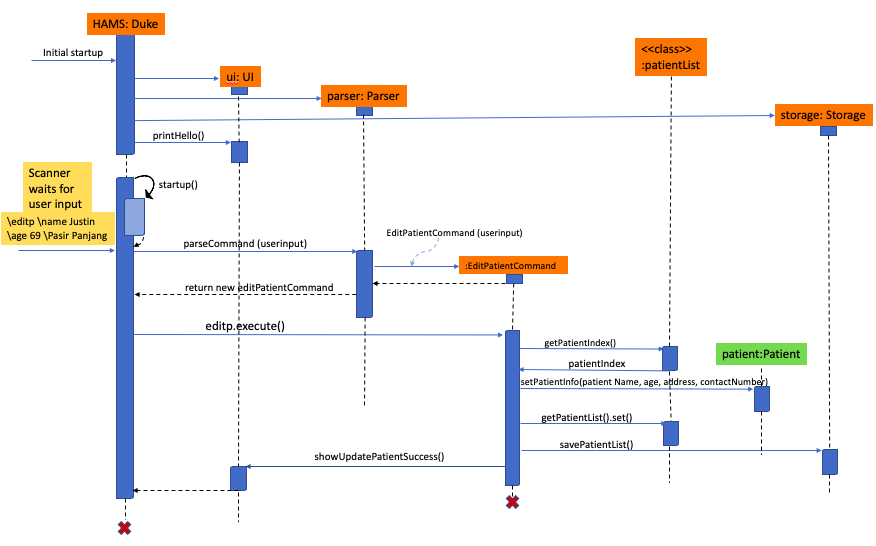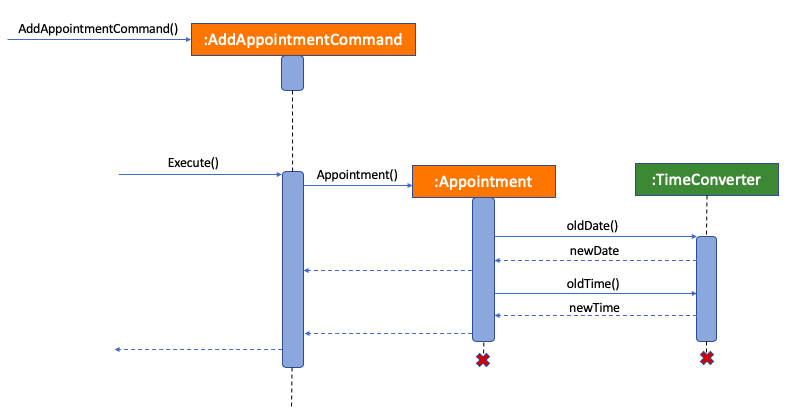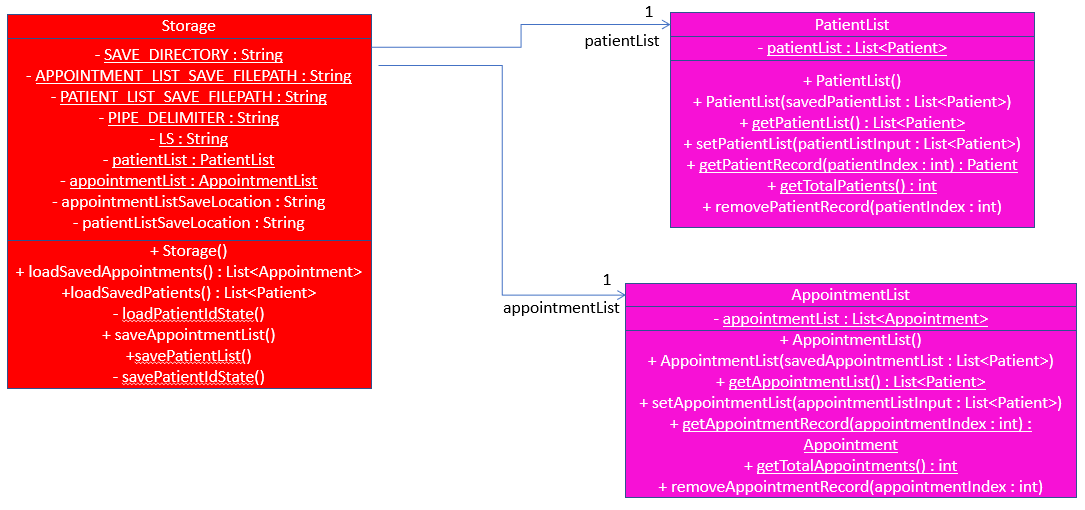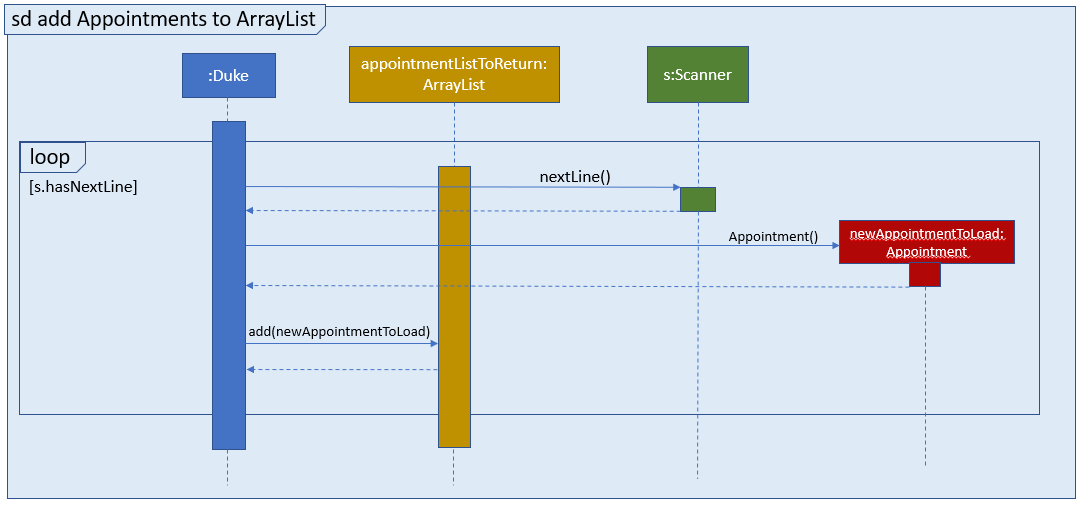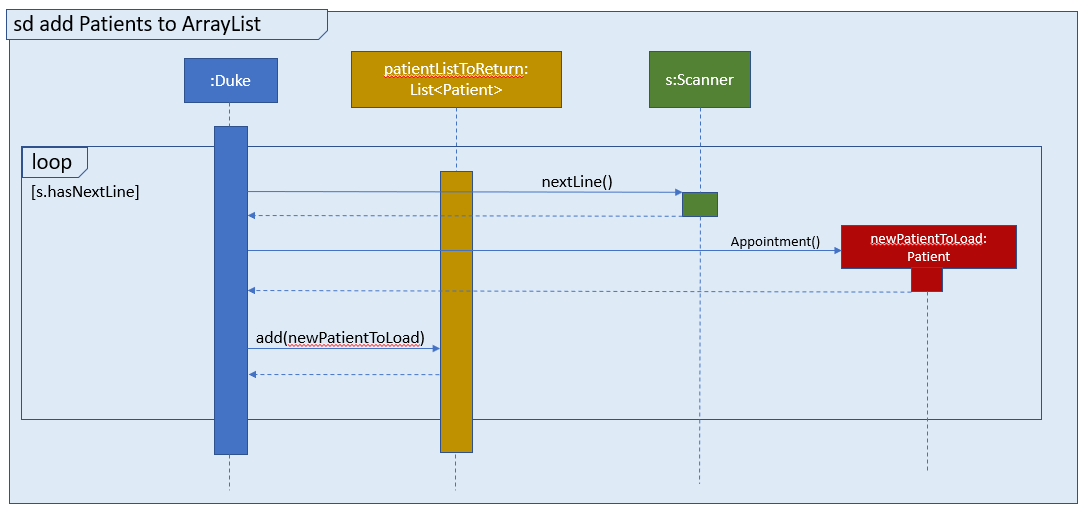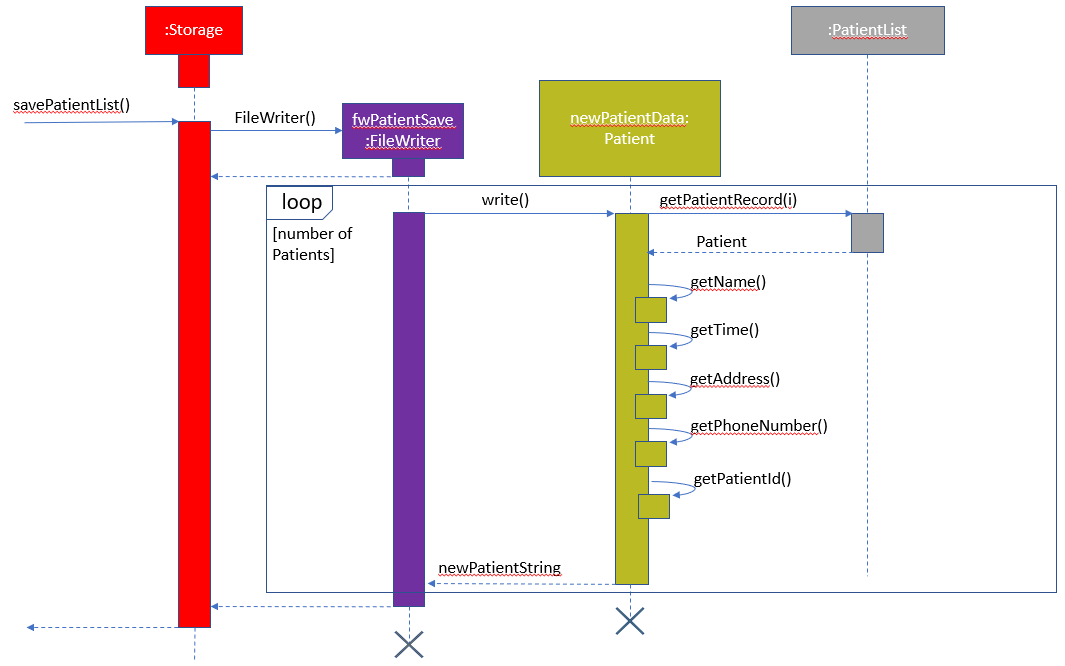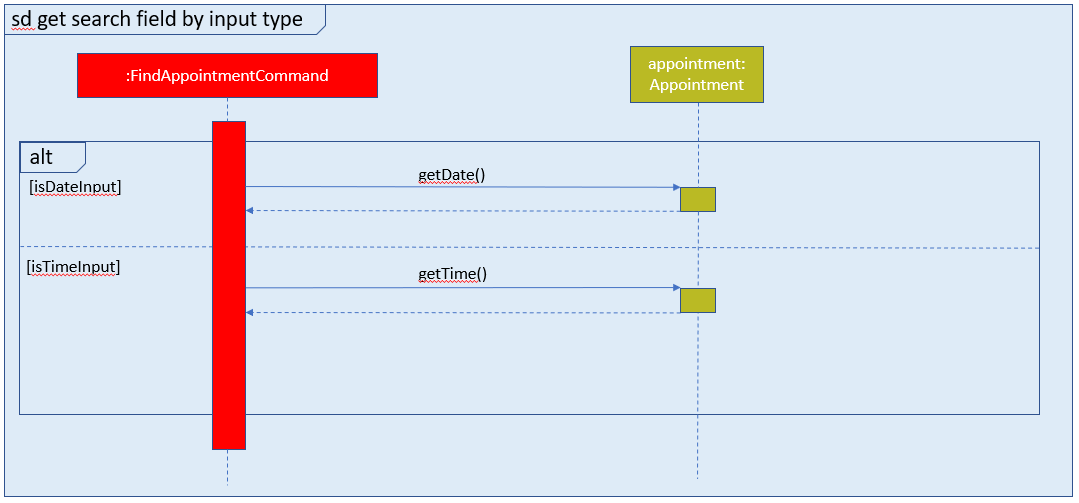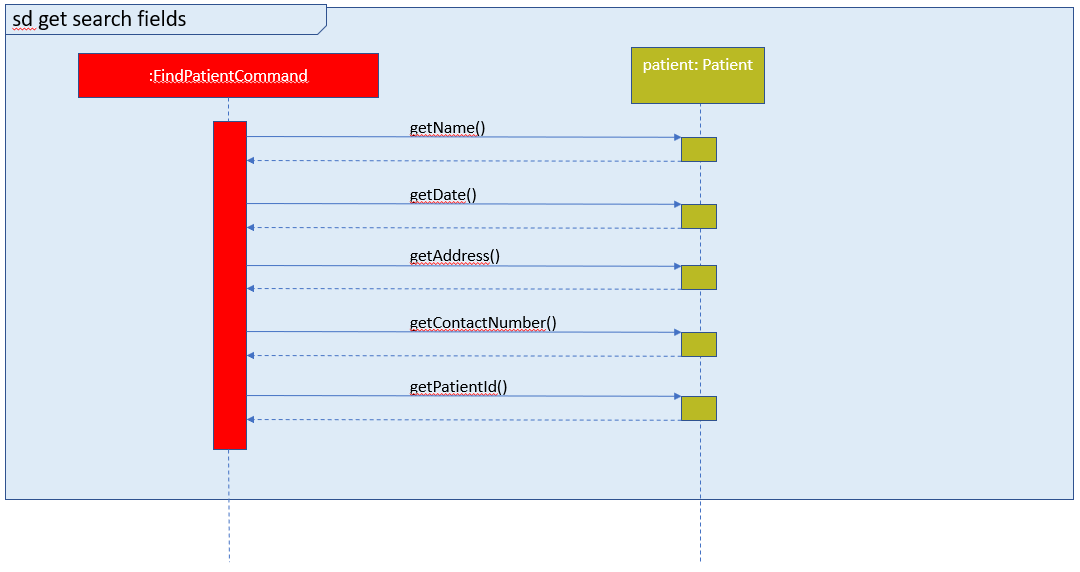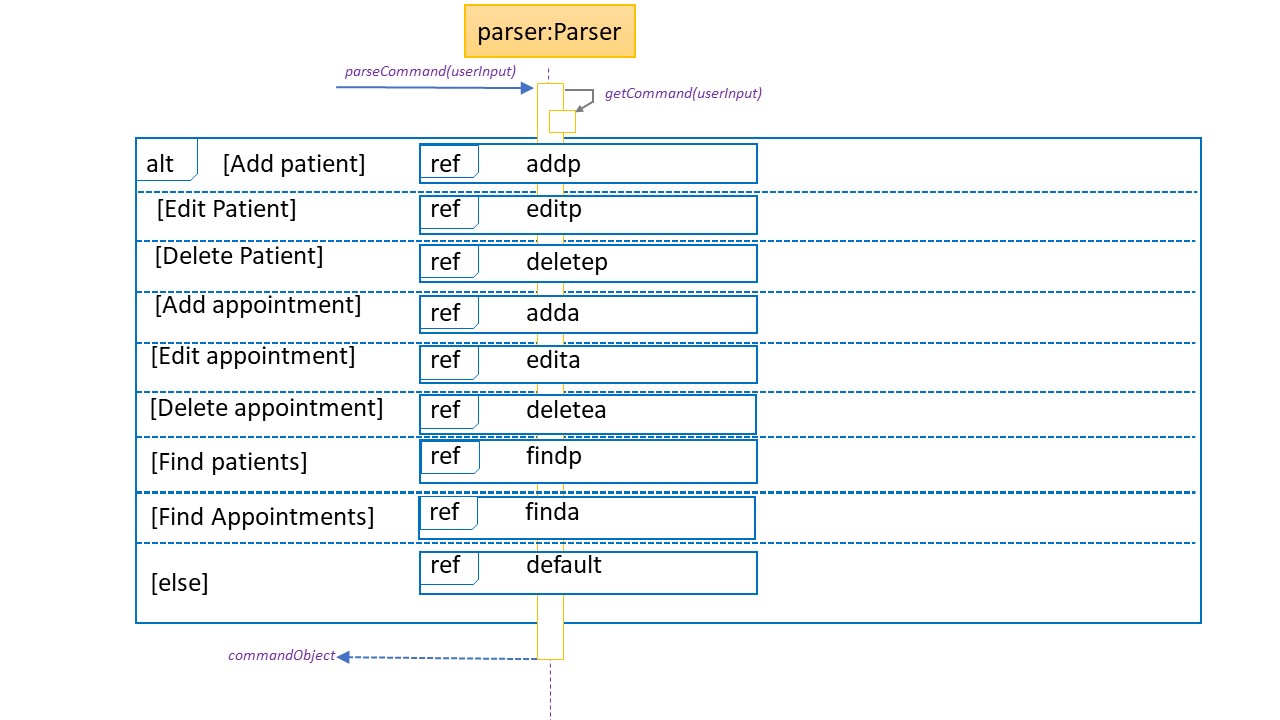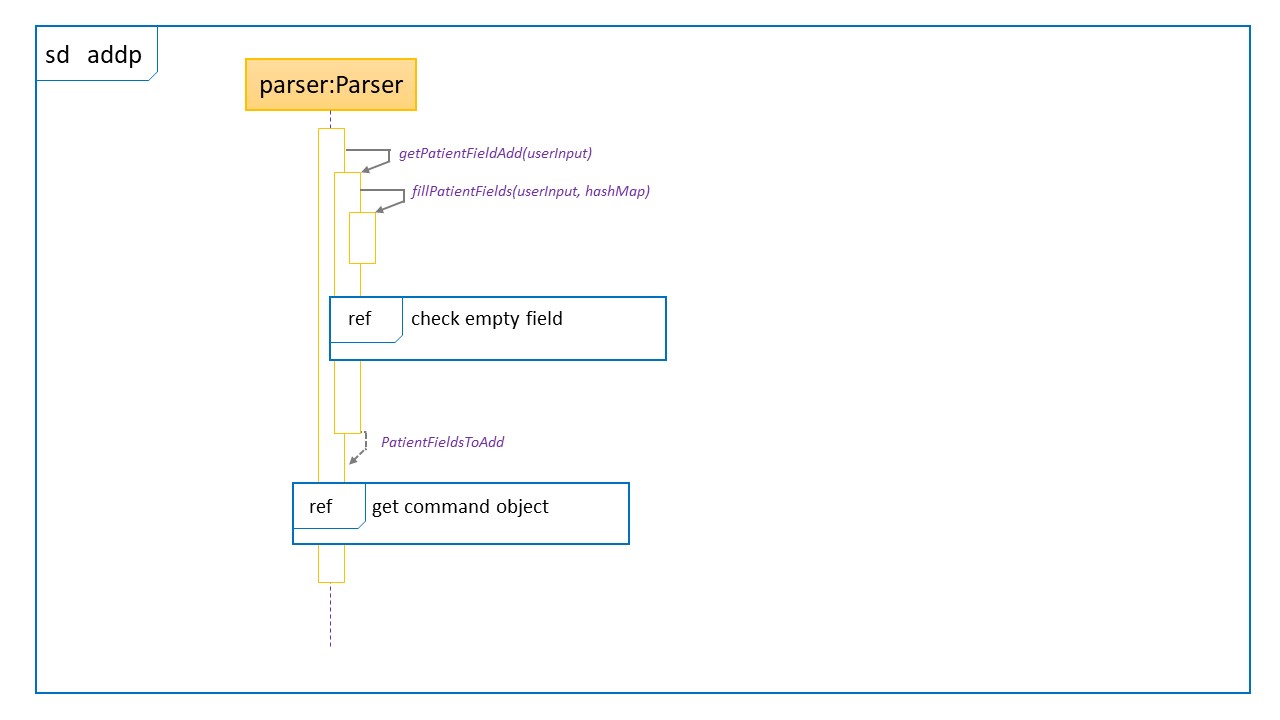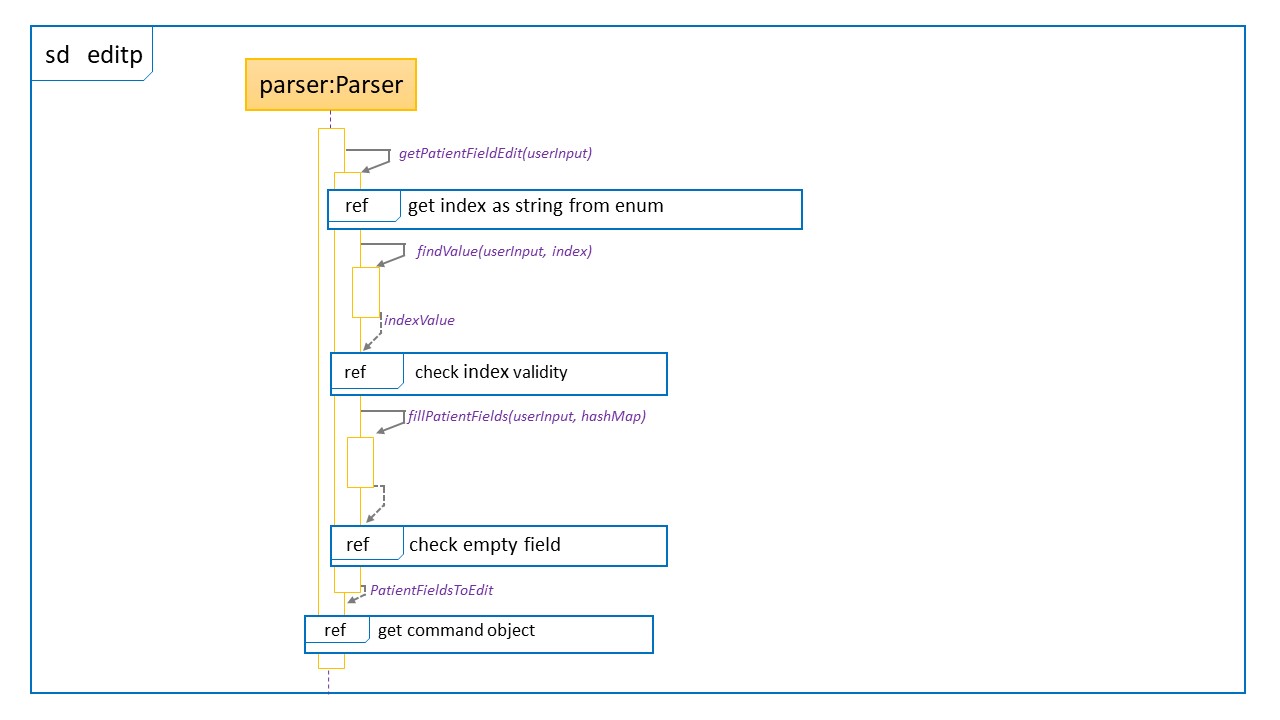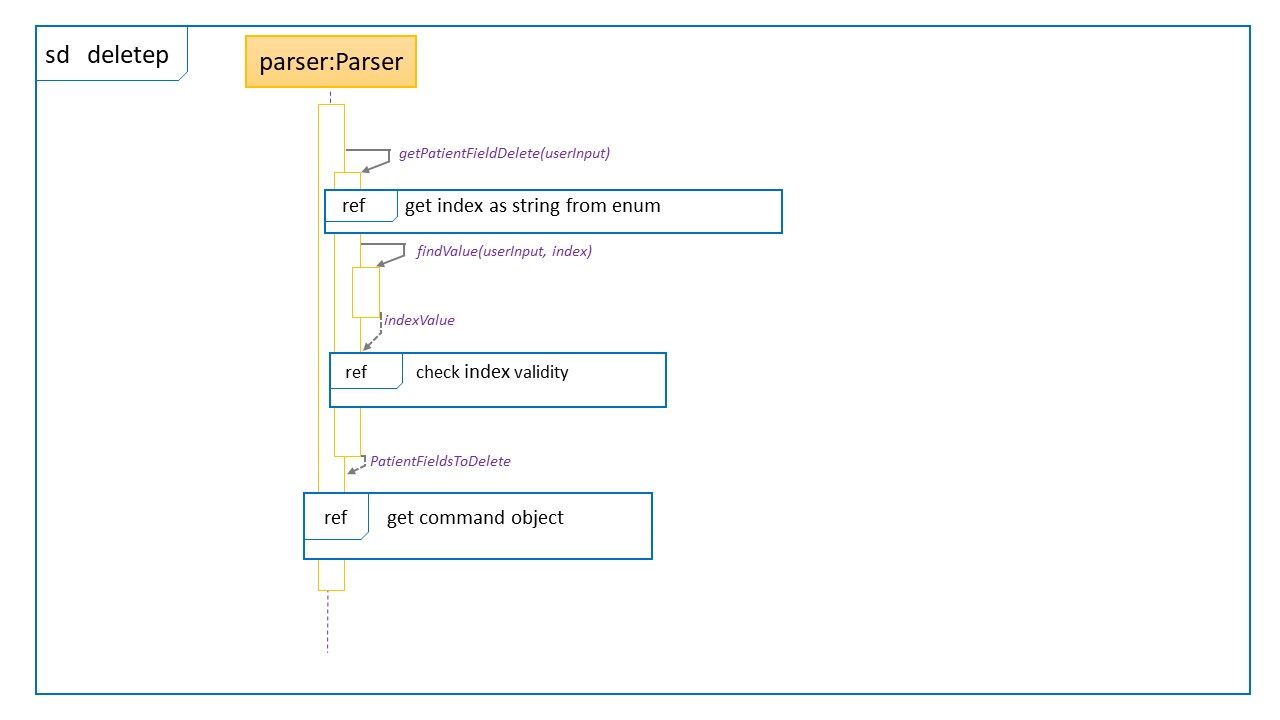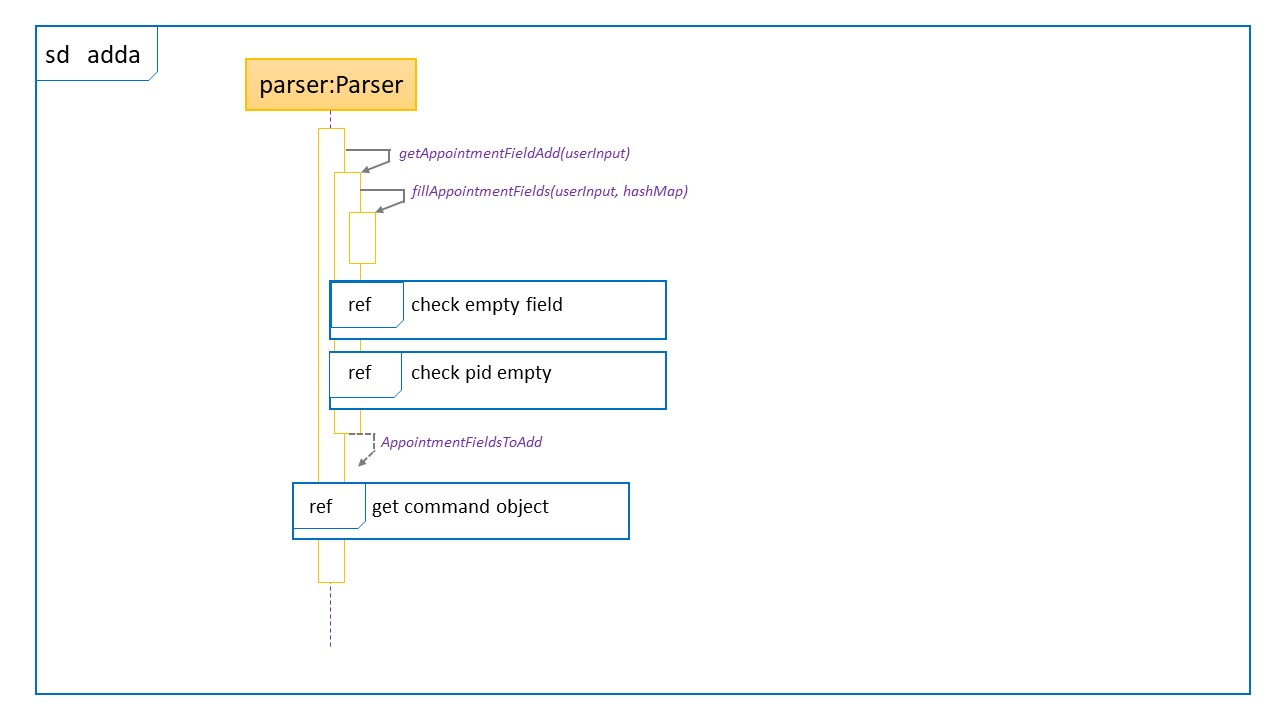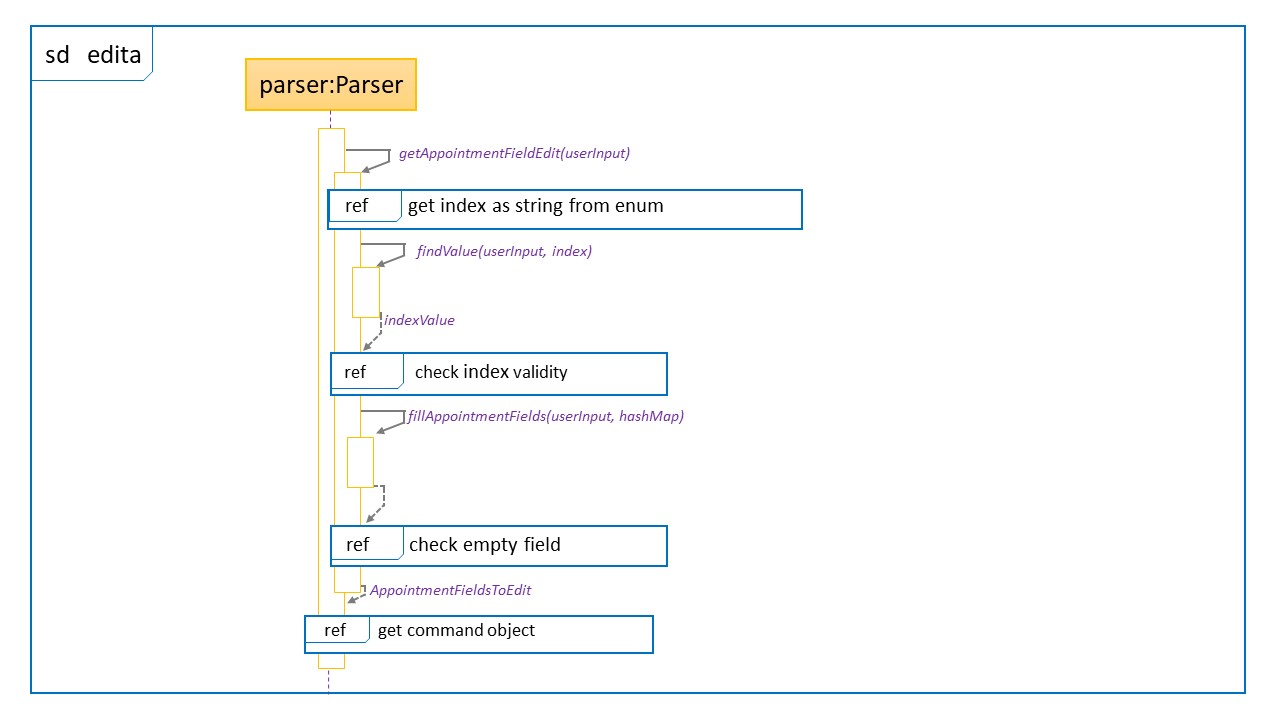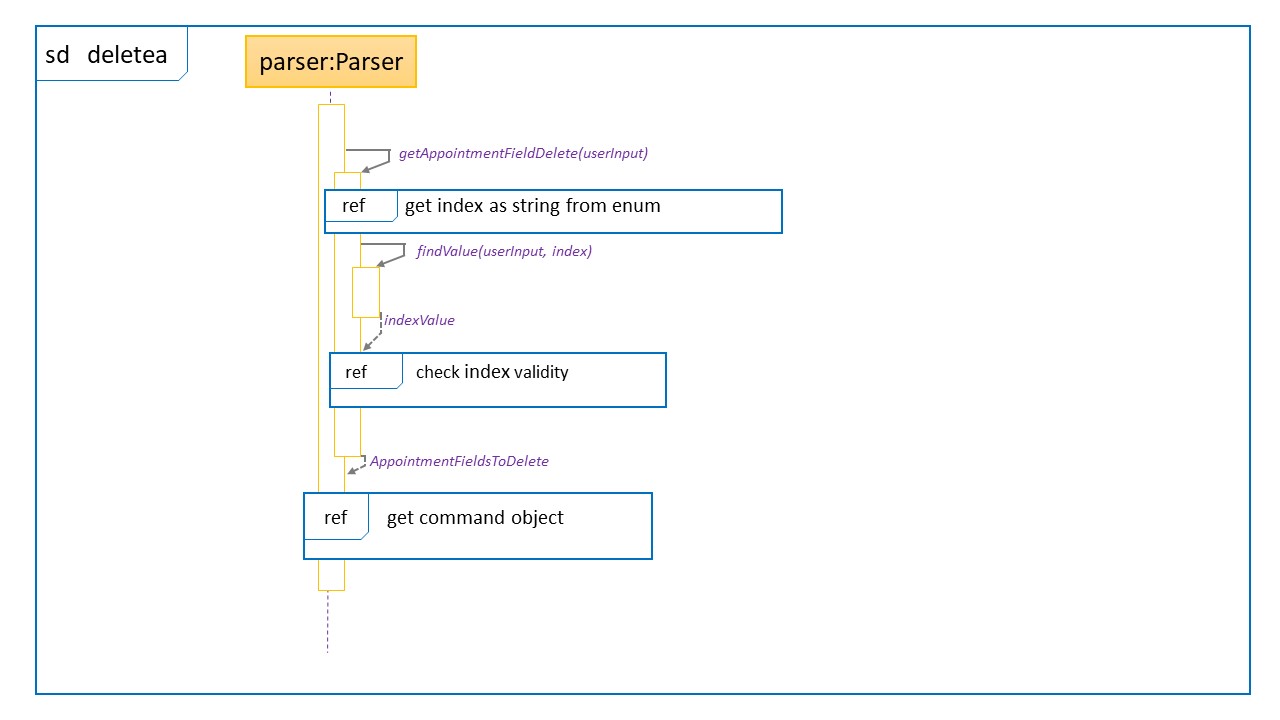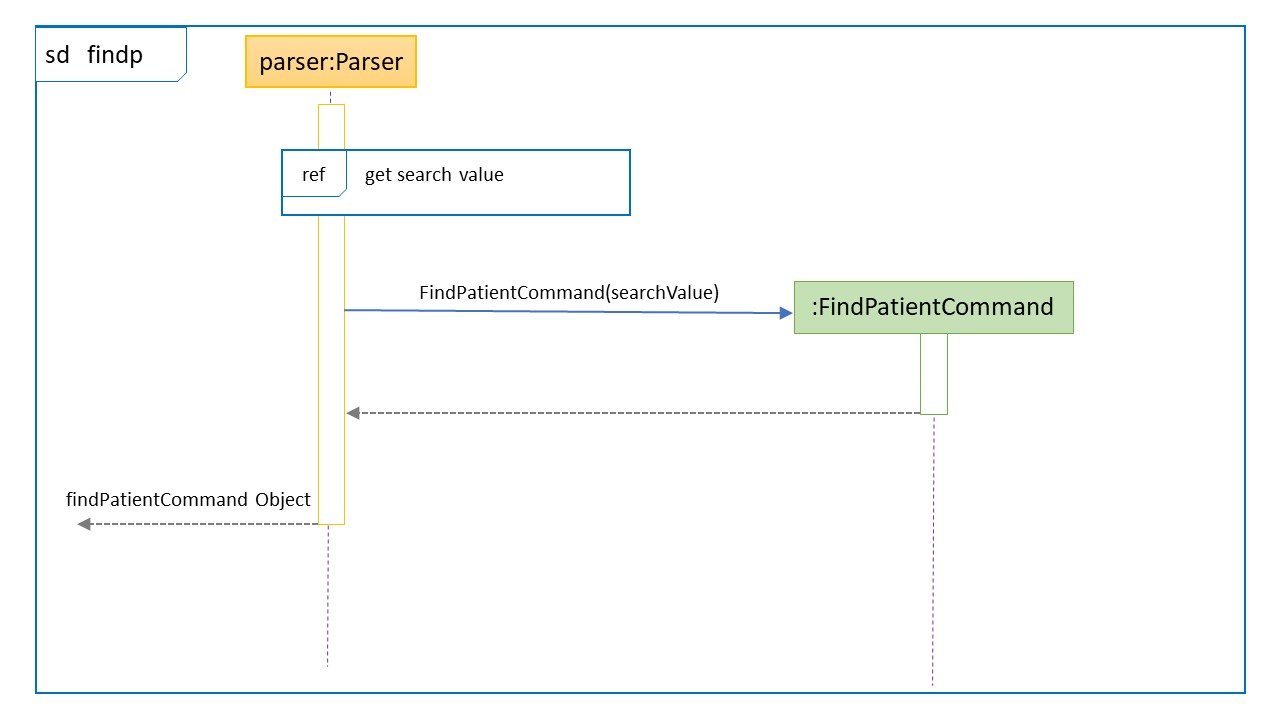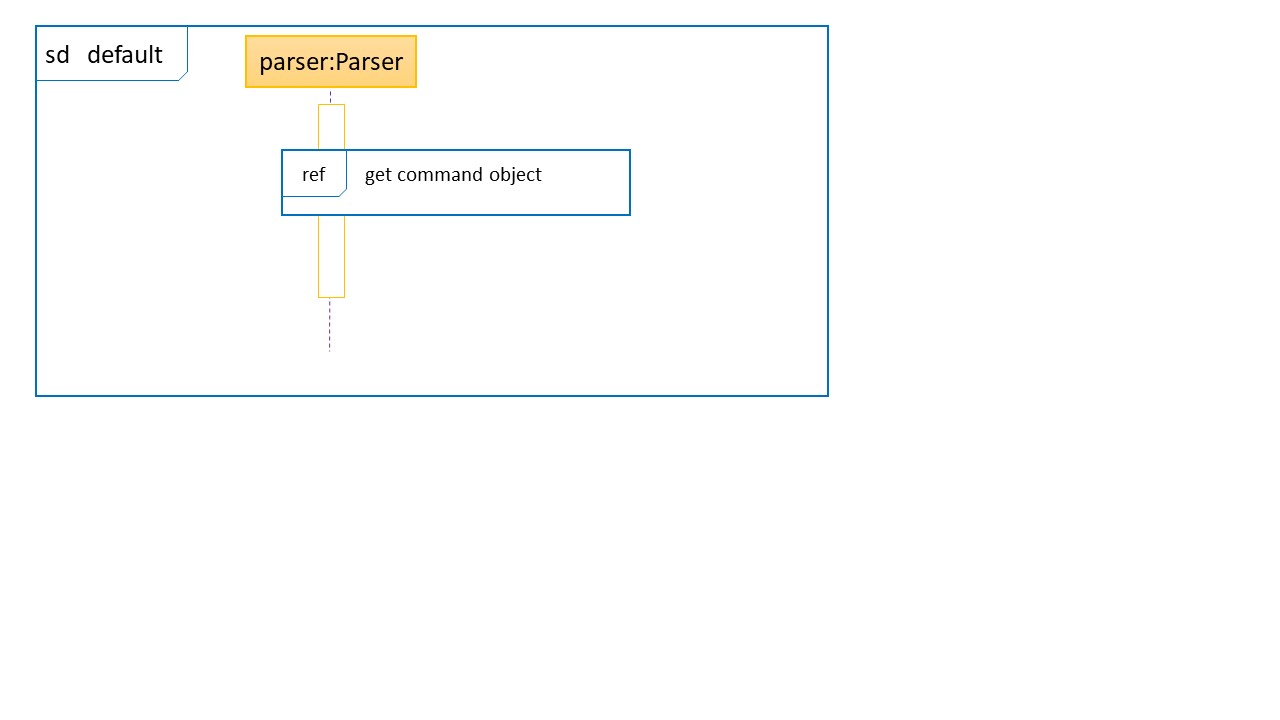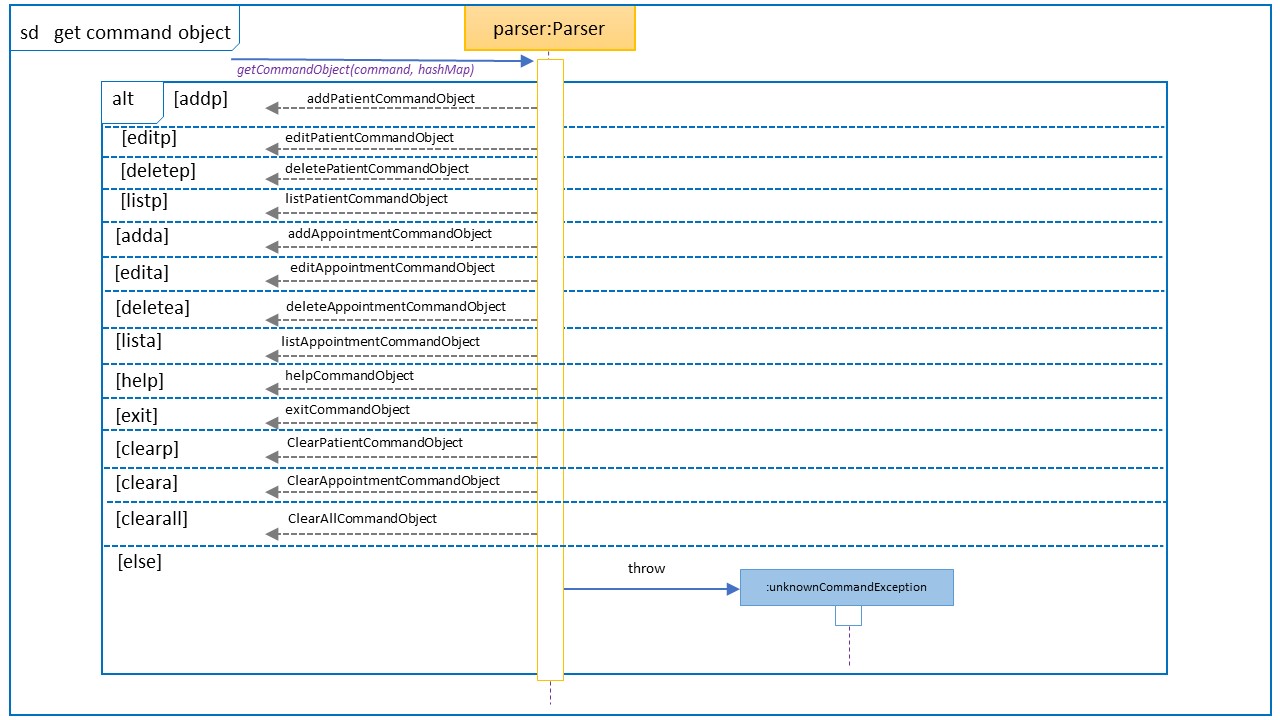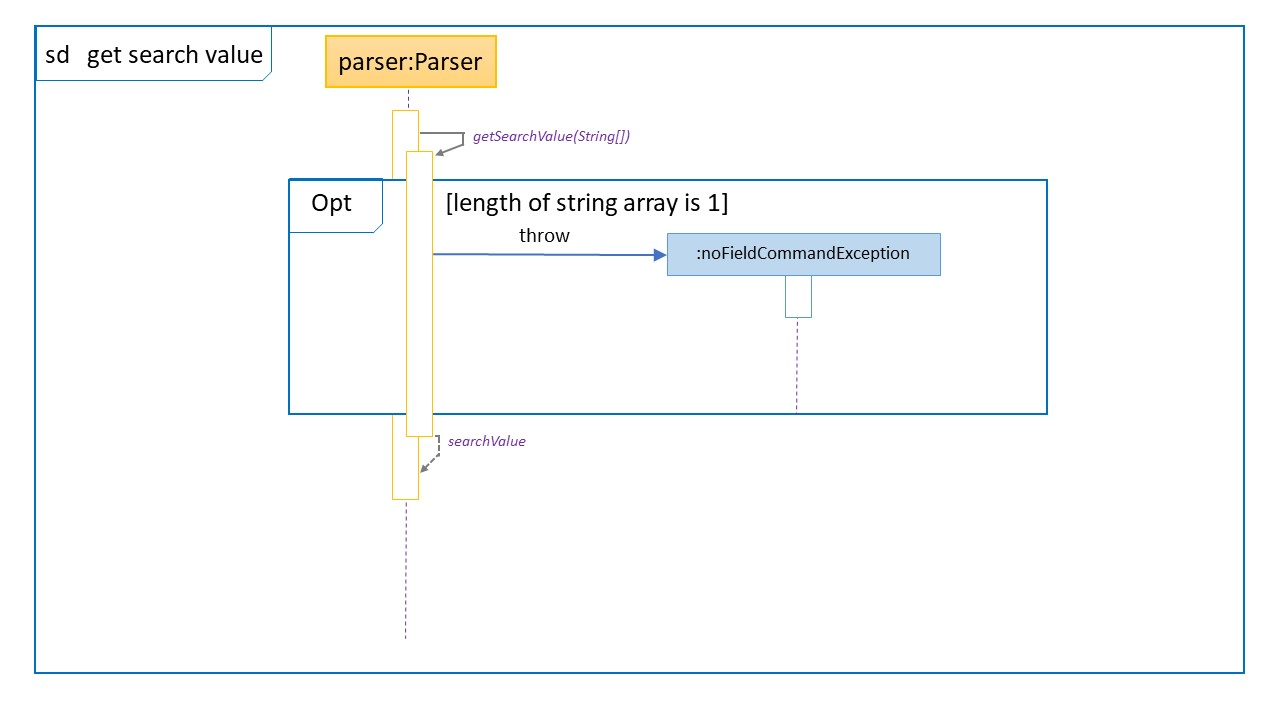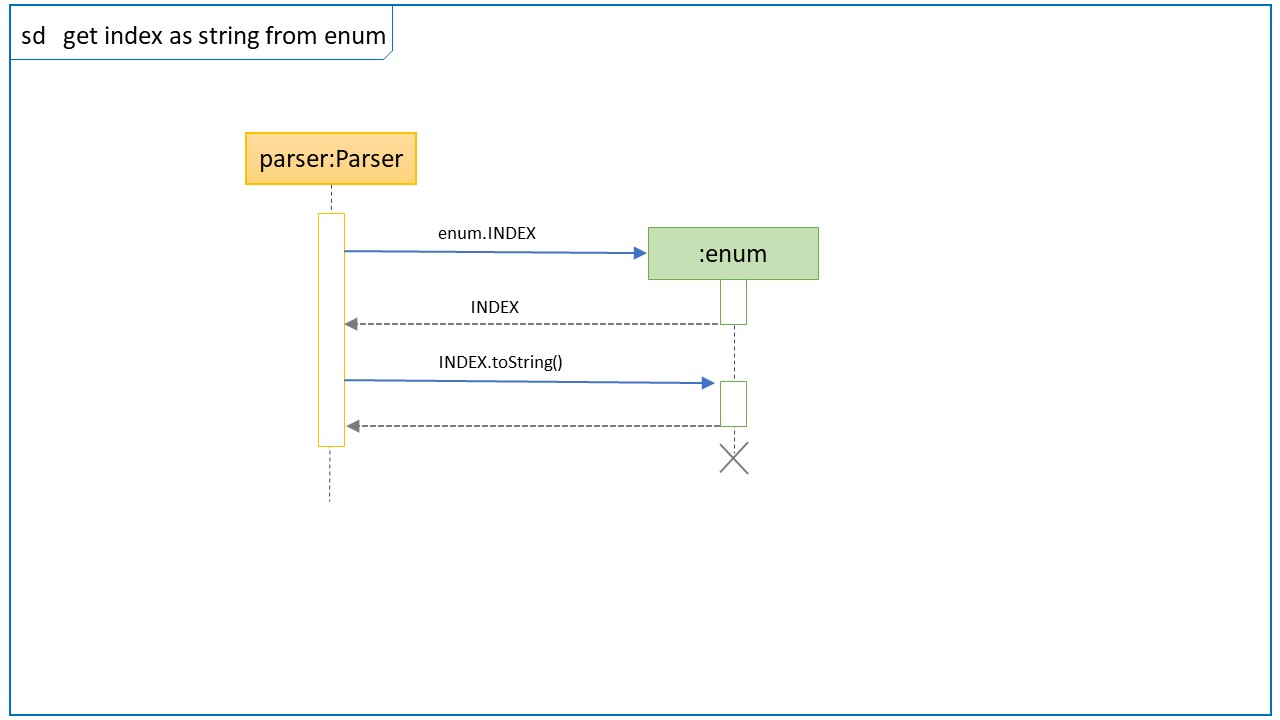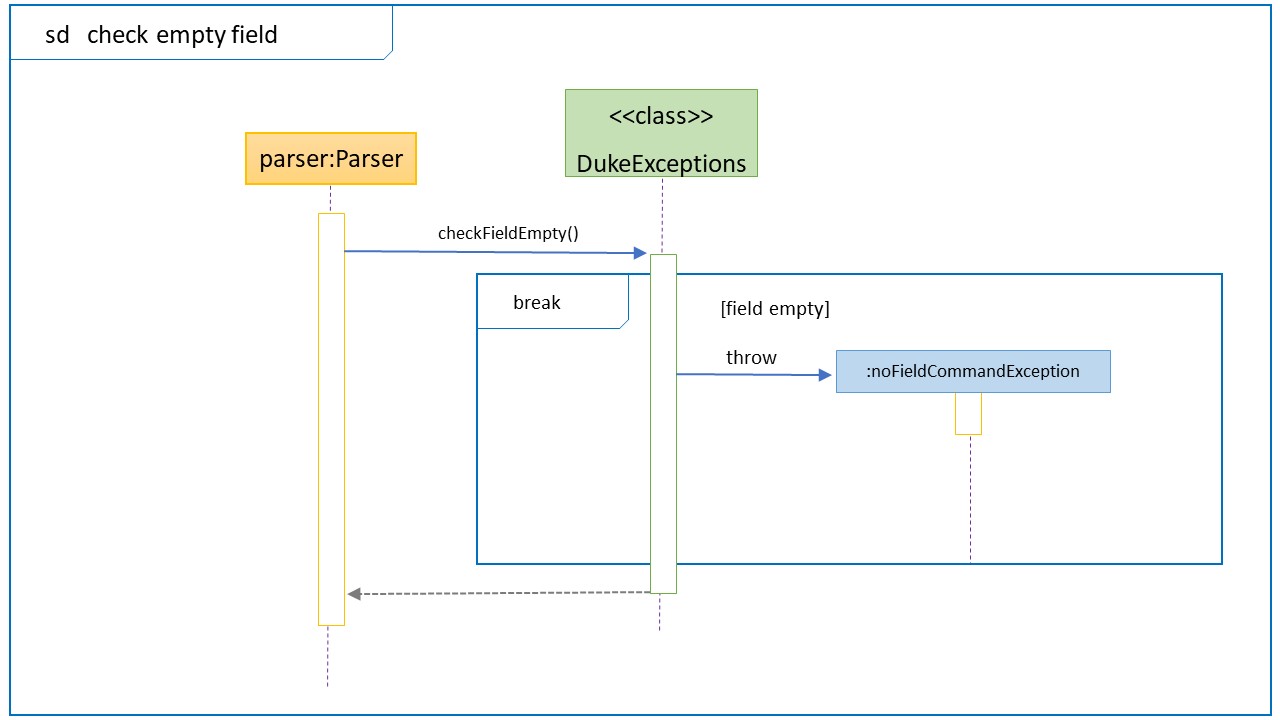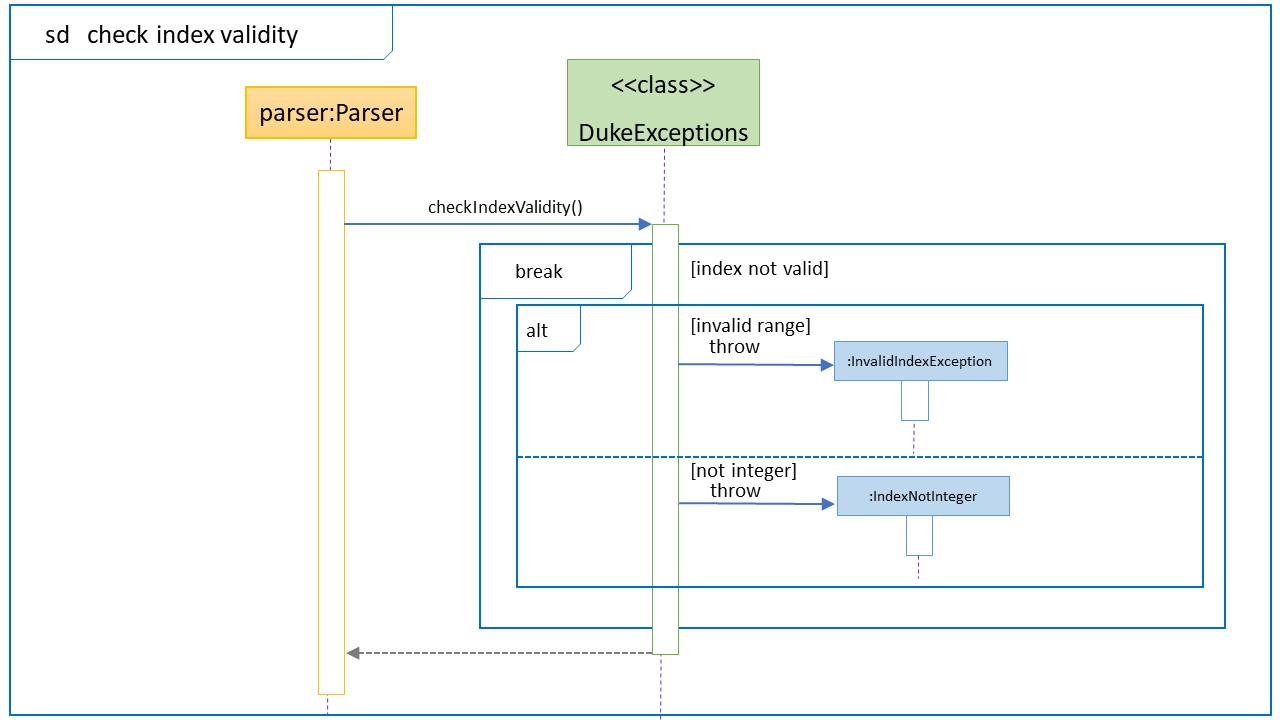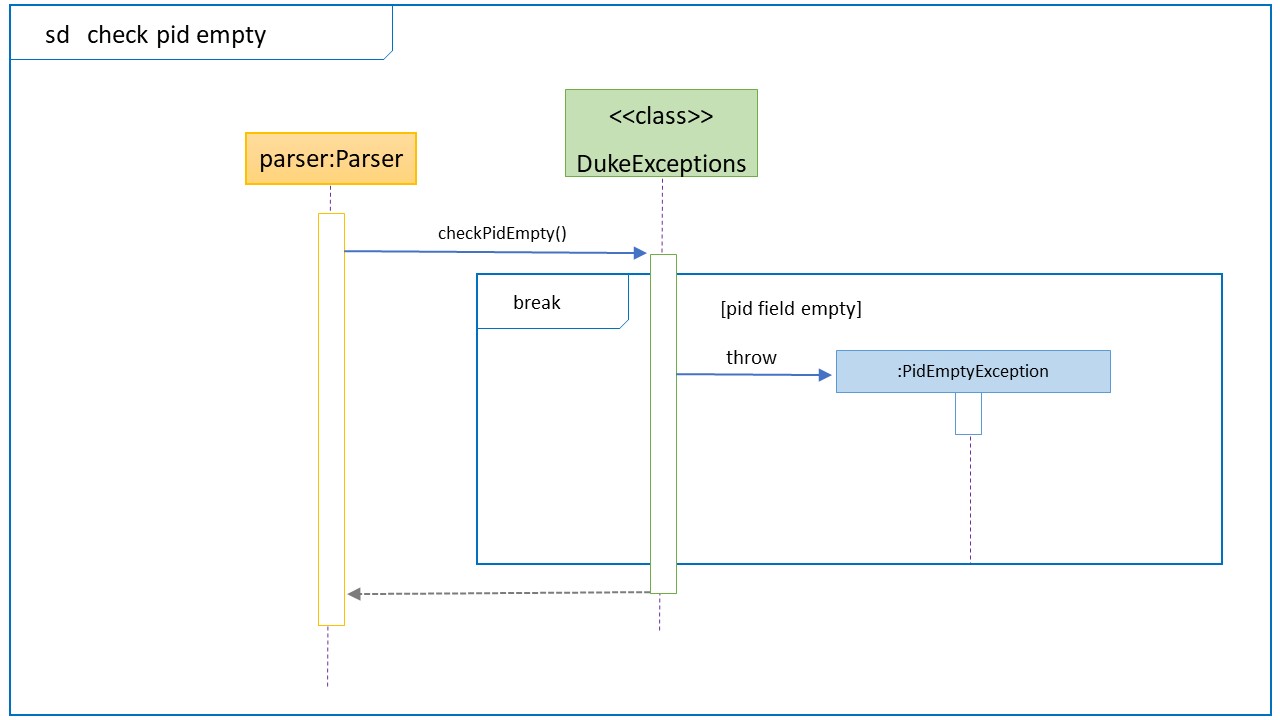Developer Guide
Table of content
- 1. Introduction
- 2. Design & Implementation
- 2.1. Project Overview
- 2.2. Module Overview
- 2.2.1. Record module
- 2.2.2. Converter module
- 2.2.3. Storage module
- 2.2.4. Command module
- 2.2.4.1 AddPatientCommand Class
- 2.2.4.2 AddAppointmentCommand Class
- 2.2.4.3 ListPatientCommand Class
- 2.2.4.4 ListAppointmentCommand Class
- 2.2.4.5 PatientIdManger Class
- 2.2.4.6 Design considerations for 2.2.4.1 to 2.2.4.5
- 2.2.4.7 EditAppointmentCommand Class
- 2.2.4.8 EditPatientCommand Class
- 2.2.4.9 DeleteAppointmentCommand Class
- 2.2.4.10 DeletePatientCommand Class
- 2.2.4.11 ClearAllCommand Class
- 2.2.4.12 ClearAppointmentCommand Class
- 2.2.4.13 ClearPatientCommand Class
- 2.2.4.14 FindAppointmentCommand Class
- 2.2.4.15 FindPatientCommand Class
- 2.2.4.16 HelpCommand Class
- 2.2.4.17 ExitCommand Class
- 2.2.5. Parser Module
- 2.2. Module Overview
- 2.1. Project Overview
- 3. User Stories
- 4. Non-functional requirements
- 5. Instructions for manual testing
1. Introduction
1.1. Purpose
This document specifies the architecture and software designs for Hospital Administrative Management System (HAMS).
1.2. Product Scope
1.2.1. Target User Profile
The intended audience of this documentation are the developers, designers, software testers, operators and maintenance engineers. The below table summarizes the purposes of reading for each audience.
| Role | Purpose |
|---|---|
| Developers & Designers | To understand the architecture and follow the design to build the system |
| Software testers | To understand the internals of the system so as to test more effectively |
| Operators | To improve productivity while using the system on a daily basis |
| Maintenance Engineers | To understand how the system was built in order to perform enhancement or re-engineering work |
1.2.2. Value Proposition
We are focused on providing a user-friendly application for front-desk administrative support assistants to quickly create, edit and delete patients’ information and appointments.
| Stakeholders | Value |
|---|---|
| Patients | Accelerated waiting process |
| Front-desk administrative staff | Improved organisation in patient and appointment details. Potential automated notification processes |
| Clinics and hospitals | Reduce occurrences of missed appointments, thus allowing reduced time and money wastage |
1.3. Definitions
|Term|Description|
|—-|———–|
fields|Fields refer to what are the accepted formats the Parse will search for in the User Input.
For example: addp \name Justin \age 23 \address Pasir Ris
The fields in the above command will be \age, \address and \name.
View the full list of fields here or on our User Guide here |
field-values| This refers to the value that exists after a field.
For example: addp \name Justin \age 23 \address Pasir Ris
The fields in the above command will be \age, \address and \name and its corresponding value will be 23, Pasir Ris, Justin.
Back to top ↑
2. Design & Implementation
2.1 Project overview
HAMS is built using java. Under java’s write once run anywhere, HAMS can be built on any platform including Windows, MAC-OS and Linux. When running locally on these system, HAMS uses as custom save configuration called BRillant Ahead of its time Neat Dainty OrigiNal (BRANDON) for loading and saving data. This allows HAMS’ internal list to be modified by operators before and during run time.
2.2 Module Overview
The major code can be broken down into modules. The below table is the breakdown of the module’s custom name and a summarized purpose.
TODO
| Module name | Purpose |
|---|---|
| Records | Contains and provides access to user information |
| Converter | Formats user input |
| Storage | Saves existing Records to local file/loads save file data to HAMS |
| Commands | Facade classes that deals with input so that different classes can interact with each other |
| Parser | Parses the user input for command execution |
2.2.1 Record module
The record module consists of 2 classes which represent the patients information and appointment details. As a reflection of real world objects, the Patient’s class purpose is to store the particulars of a person while the Appointment’s class is to store the date-time data. Thus, the rationale of both classes can be grouped as follows:
As a reflection of real world entities, to create, store, and retrieve relevant information about the object.
Following the above purpose, both classes consist of only getter and setter methods. This would ensure a contiguous flow in logical executions as these methods can be called whenever necessary.
2.2.1.1 Process of Object Creation
Due to the nature of the above classes containing only getter and setter methods, following how the components interact with each other would provide more accuracy in understanding how these classes are called and the role of its methods. To illustrate, the below example is used:
- editp \index 1 \name Justin \age 69 \Pasir Panjang
Upon startup, objects from ui, parser and storage are created. Prompted for user input, Duke receives the “editp”
command which is forwarded to the parser to be interpreted respectively. Once the EditPatientCommand object is
created, it retrieves the patient index to edit the existing patient information from the patientList.
The Patient class is called by its setter method, setPatientInfo(), to update the fields as provided by the user.
This ensures that the encapsulated variables such as age, name, contact number and address are not only enforced but
also protected.
2.2.1.2 Design Considerations
Aspect: Data Type for Appointment’s Date and Time
- Alternative 1 (current choice): Store as a String
- Pros:
- Easier implementation
- Greater user flexibility
- Cons:
- Cannot sort if needed
- Pros:
- Alternative 2: Store as Date
- Pros:
- Has flexibility to parse or format date using existing methods available for use.
- Cons:
- Immutable-value classes mean it is not thread-safe (using Java.util.SimpleDateFormat).
- Pros:
Back to top ↑
2.2.2 Converter Module
The converter module consists of one class which converts the format of date and time using a custom format defined by
special formatting characters (ie. SimpleDateFormat). This class is primarily used to format a user-input date and time
in the Appointment class. As illustrated below, its methods are called during the creation of the Appointment
object constructor.
Back to top ↑
2.2.3 Storage module
The Storage module consists of 3 different classes. The PatientList and AppointmentList classes act as data structures to store the records of Patient and Appointment objects respectively. They function as ADTs, where various commands from Command objects can manipulate the records within.
The Storage class manages the load and save operations involving the PatientList and PatientList class. These operations are usually invoked on startup, whenever changes are made to the ADTs and before exiting the program. Additionally, it also works with PatientIdManager class to load pre-existing Patient-PatientId mappings. The class diagram for the storage module is as seen below:
2.2.3.1 Process of Object Creation
On startup, Duke invokes the loadSavedAppointment() and loadSavedPatient() methods in Storage. This allows the program
to retrieve previously stored data from a .txt file and convert it into the static AppointmentList and PatientList objects for use
within the program.
For Appointments, the Storage object creates a Scanner object that will parse individual lines in the .txt file, convert them into
new Appointments, and then add them to an ArrayList of Appointments called appointmentListToReturn. This appointmentListToReturn will be passed back to Duke to
construct the static AppointmentList.
For Patients, the process is the same as above. The difference is that lines in the .txt files are converted to Patient objects instead.
They are added to an ArrayList of Patients called patientListToReturn. patientListToReturn is then passed back to Duke to construct
the static PatientList.
The sequence diagrams for both loadSavedAppointment() and loadSavedPatient() are shown below:
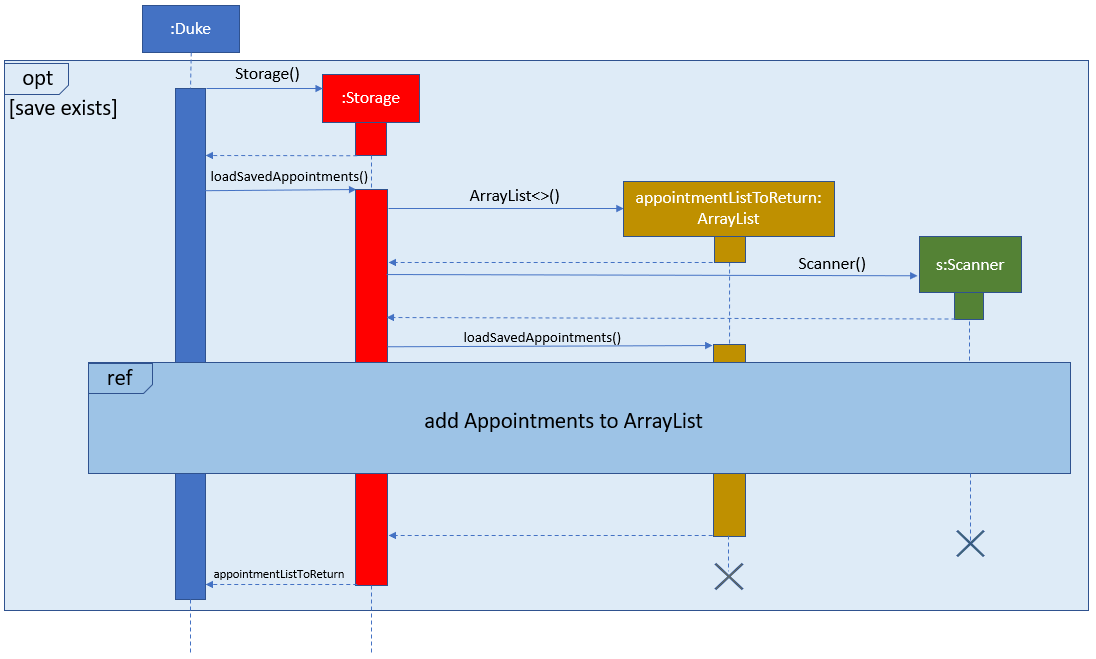
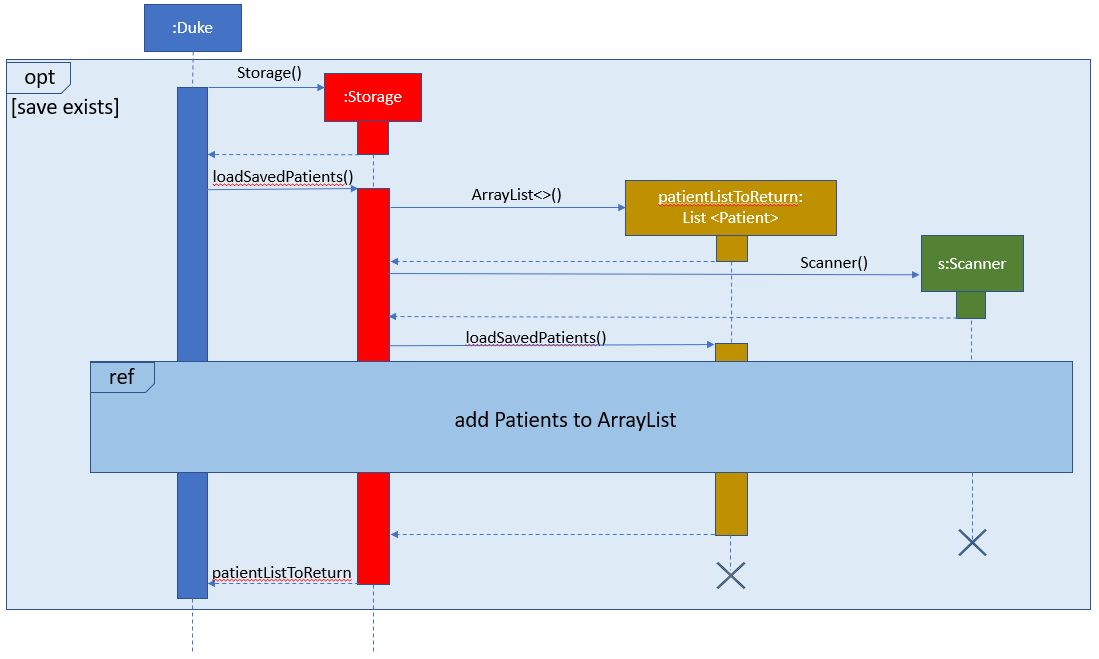
When the static AppointmentList or PatientList has changes, or the program is exiting, saveAppointmentList() or savePatientList()
is invoked respectively. This allows the Storage object to back up existing records to a local .txt file.
For Appointments, the Storage object will create a FileWriter object called fwAppointmentSave. The command will then iterate through the existing AppointmentList
and parse each Appointment within, converting it to a string. fwAppointmentSave then writes this string to the .txt file appointments.txt.
For Patients, the process is the same as above. The difference is that Storage object creates a FileWriter object called fwPatientSave instead.
fwPatientSave writes Patient strings to the file patients.txt.
The sequence diagram for saveAppointmentList() and savePatientList() is shown below:
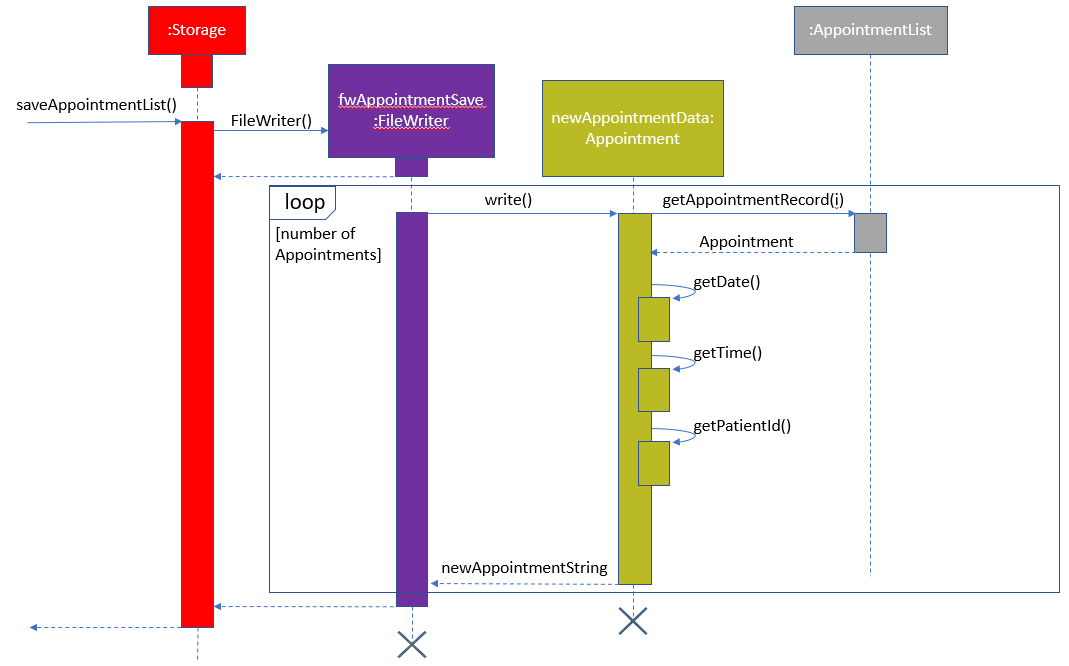
Back to top ↑
2.2.4 Command module
The command module consist of 11 different classes, where each class does a different command by itself. These classes allows the patients and appointments to be added into HAMS, allows the updating of patient and appointment details, allows the admin to delete patients and appointment information and allows of listing of the different patients and the appointments in HAMS. In addition, the classes also deals with displaying the list of commands and as well as to allowing HAMS to exit.
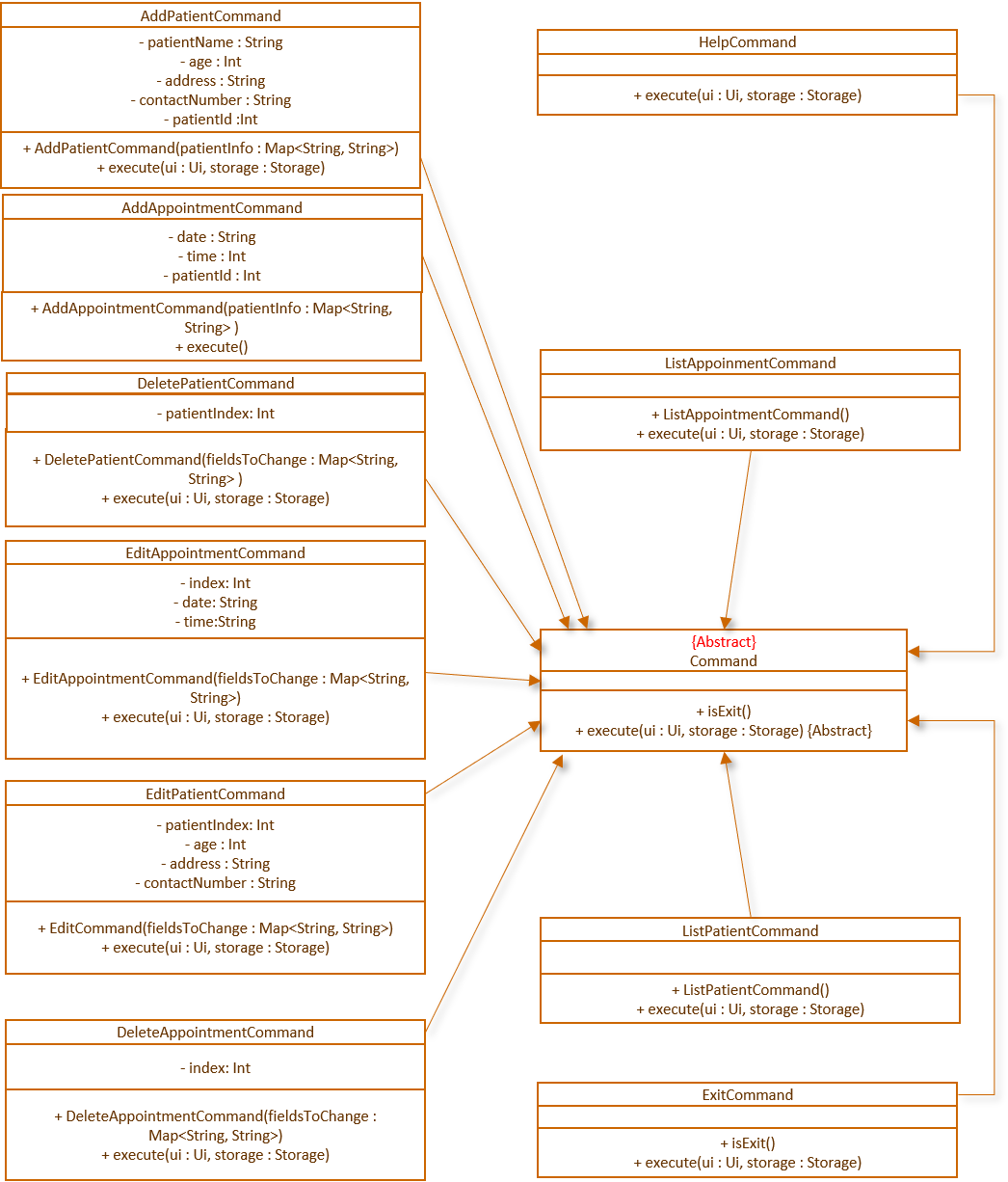
All of these command classes inherits from the abstract Command class. Likewise, the execute function of each
command class is also inherited from the abstract Command class’s execute(Ui ui, Storage storage) function
too. Every command class (other than the ExitCommand and HelpCommand) are actually façade classes that
creates the connection from the Main class to the other classes required such as Storage class,
PatientList class and the Appointment class to name a few.
2.2.4.1 AddPatientCommand Class
To add a patient, the AddPatientCommand class is used. For this AddPatientCommand class, it serves as the
façade class for the Main, Patient , PatientList and the Storage class to interact with one
another. Also, to uniquely identify a patient, an unique patientId number is assigned to each patient when they are first added into the patient list.
Note that if the patient information given is incorrect due to formatting or value error, AddPatientCommand will return an exception and AddPatientCommand will not create a patient record.
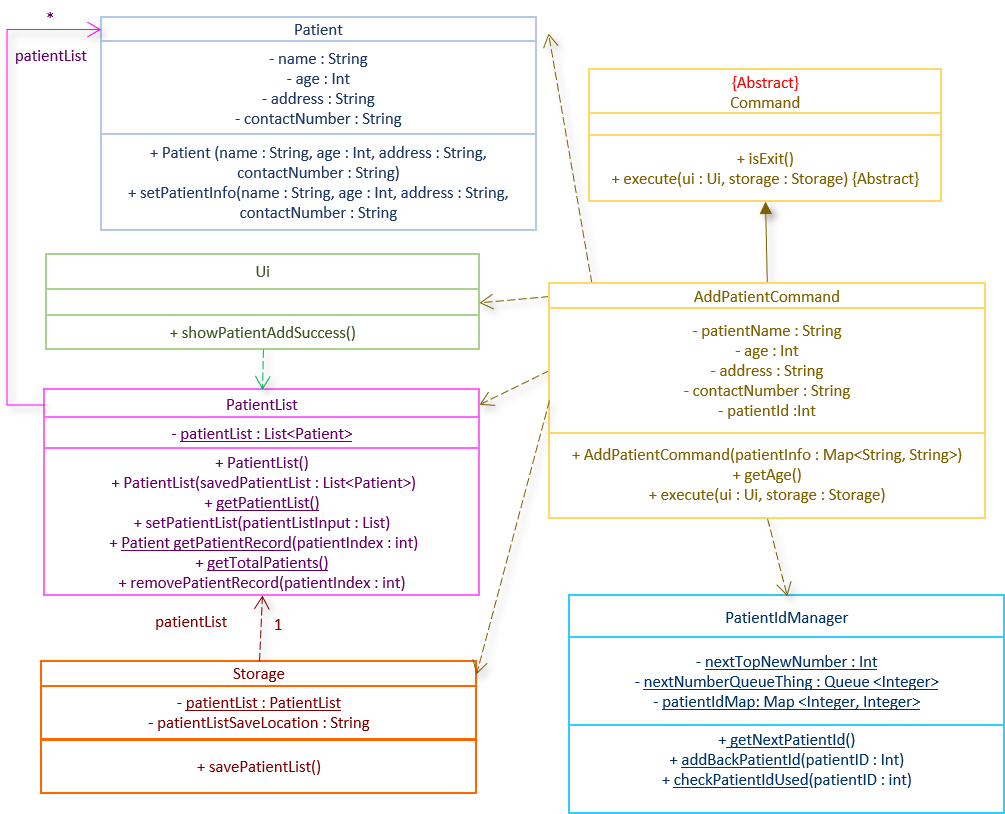
-
The
AddPatientCommandclass object will first be created by theParserobject, where the information regarding the patient to be added will be stored in a Map, where theAddPatientCommandclass object would read the Map content and store the information about the patient in saidAddPatientCommandclass object. It will also check for the format of the information given in the Map and see if the information is valid. If the information is not valid, theAddPatientCommandobject will not be created. For the patient Id number, it will call upon the static classpatientIdManagerto get its unique patient id number. This unique Id number will be used later in thePatientobject creation too. -
When the
execute(Ui ui, Storage storage)command is called, theAddPatientCommandwould first make use of thePatientclass constructor to create a newPatientobject based on the information stored back in step 1. -
After which, it would then call the
PatientList’sgetPatientList()command to get theListpatient list object such that thePatientobject created beforehand can directly be inserted into the patient list. -
After adding the patient into the patient list object, the
Storage’ssavePatientList()function will be called next so that the newly update list ofpatientis saved as offline data. -
When the above operation is successful, it will call upon the
Uiclass’showPatientAddSuccess()function to display the success of adding thePatientobject into the patient list.
If the supplied patient age is a word or is missing, the age will be set to -1. This value is chosen to indicate
that there isn’t a valid age set. Thus, when displaying the age, if -1 is encountered, show age as an empty string
instead.
Below shows the sequence diagram for AddPatientCommand class
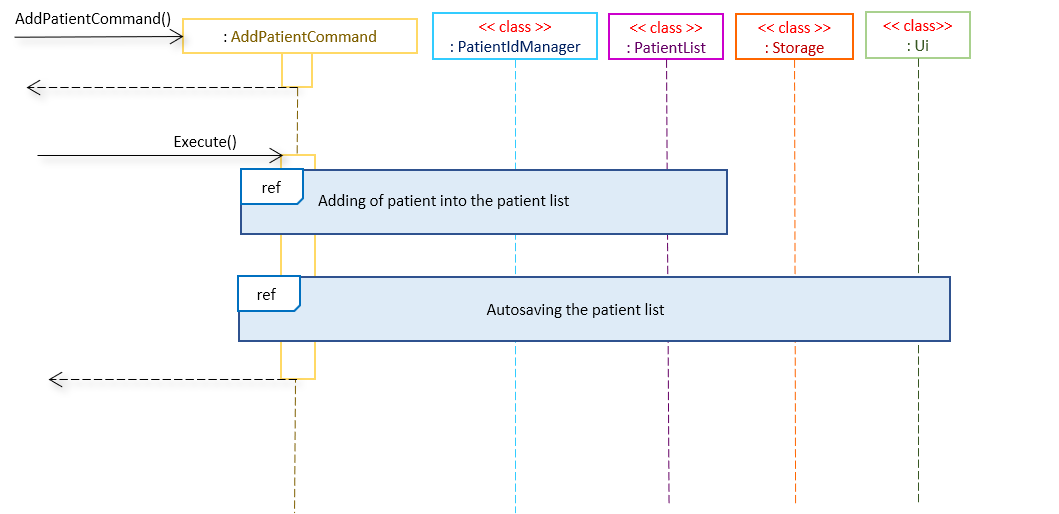
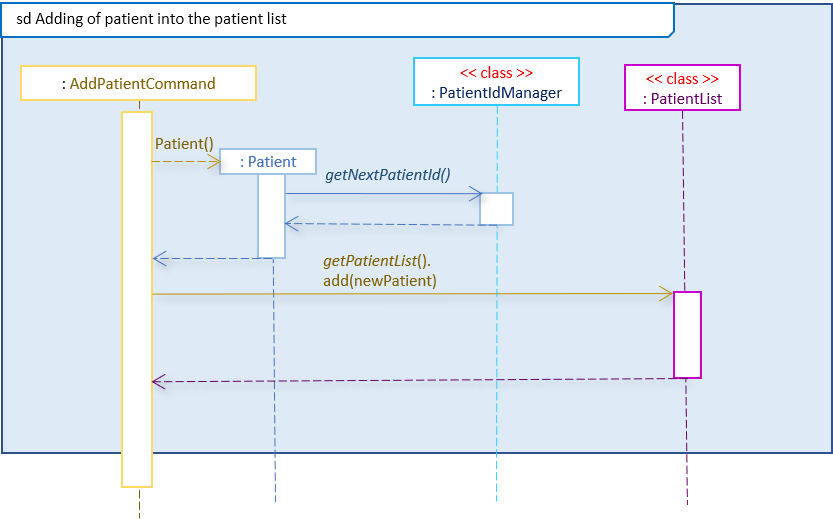
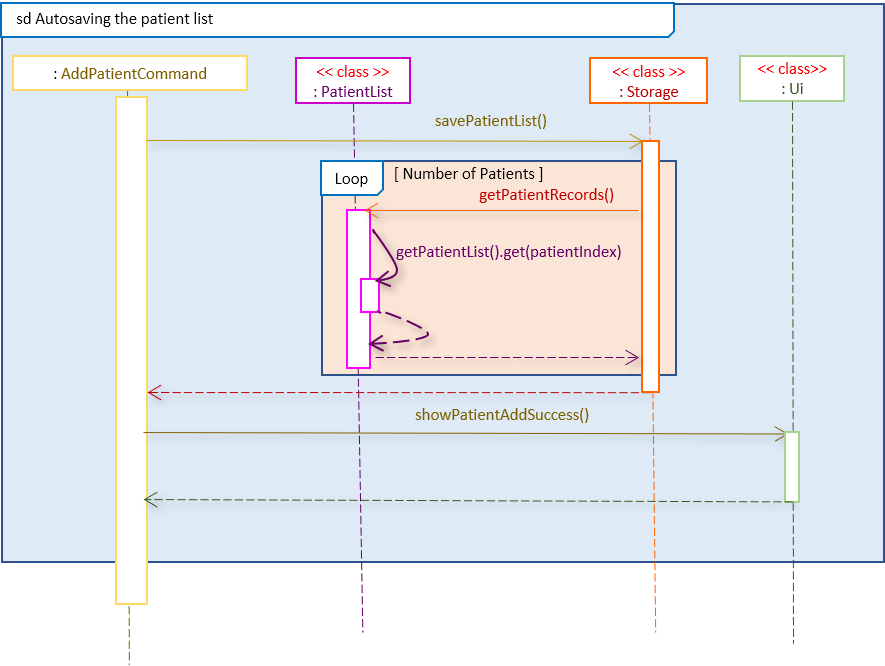
2.2.4.2 AddAppointmentCommand Class
To add an appointment, the AddAppointmentCommand class is used. For this AddAppointmentCommand class, it
serves as a façade class for the Main, Appointment, AppointmentList and the Storage class to
interact with one another.
Note that if the appointment information given is incorrect due to formatting or value error, AddAppointmentCommand will return an exception and AddAppointmentCommand will not create an appointment record.
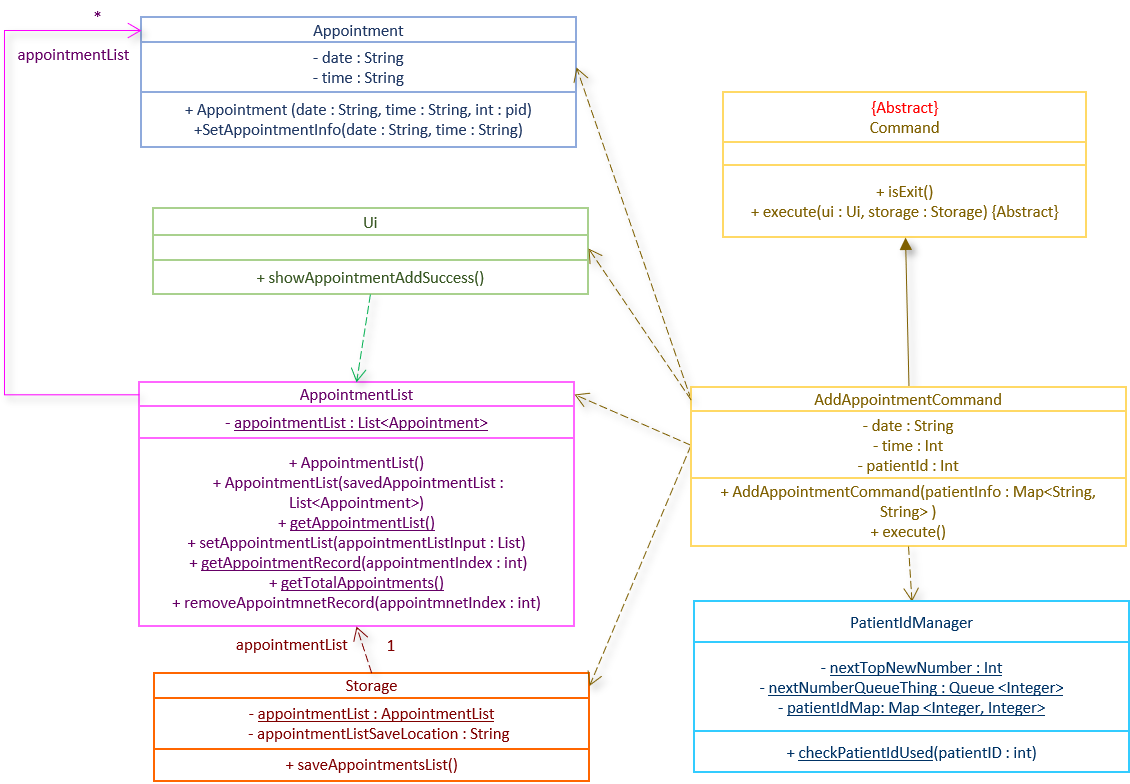
-
Like the
AddPatientCommandclass, theAddAppointmentCommandobject is first created by theParserobject, where the information of the appointment is again stored in a Map that theAddAppoinmentCommandobject would read from. Said information will be stored in theAddAppoinmentCommandobject. It will also check for the format of the information given in the Map and see if the information is valid. If the information is not valid, theAddAppoinmentCommandobject will not be created. -
When the
Maincallsexecute(Ui ui, Storage storage), theAddAppointmentCommandclass would call upon theAppointmentclass to make anAppointmentObject. Note that in the the constructor ofAddAppointmentit also checks to see if the patient id is a patient id that actually exist (as in a patient has that patient id ). This check is done by calling thecheckPatientIdUsedmethod ofPatientIdManagerclass. If the patient id supplied with the appointment detail does not belong to any of the present patients, theAddAppointmentCommandconstructor will not create theAppointmentand will show an error instead. TheAppointmentobject will only be created if the patient id that is supplied exists (as in one of the patient has said patient id). -
After which, the
AddAppoinmentCommandobject will call upon theAppointmentListobject to obtain the list ofAppointments(get theListobject that represents the list of appointments byAppointmentList’sgetAppointmentList()command) so that it can directly add the newAppointmentobject into the appointment list. -
Finally, it will call upon the
Storageclass’ssaveAppoinmentList()function to save the updated appointment list. -
Upon successfully adding the
Appointmentobject into the appointment list, it will call upon theUiclass’showAppointmentAddSuccess()function to display the success of adding theappointmentinto the appointment list.
Below shows the sequence diagram for AddAppointmentCommand class:
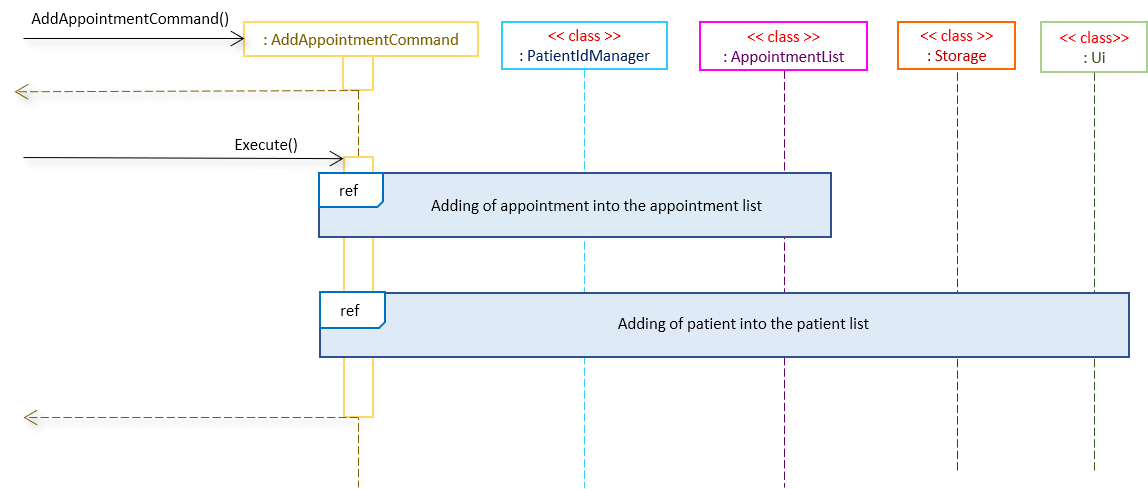
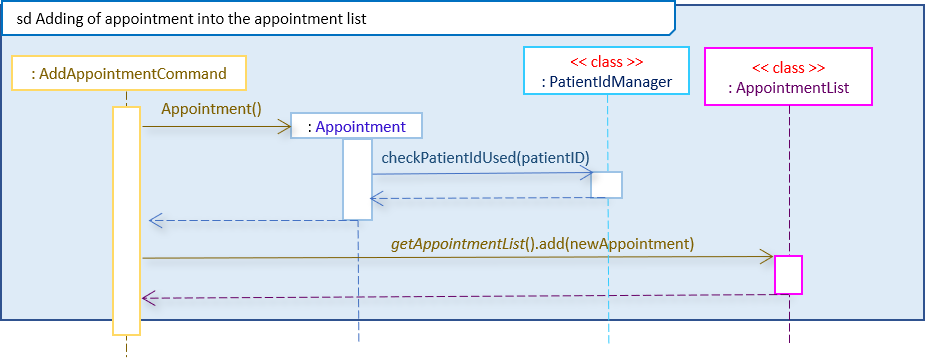
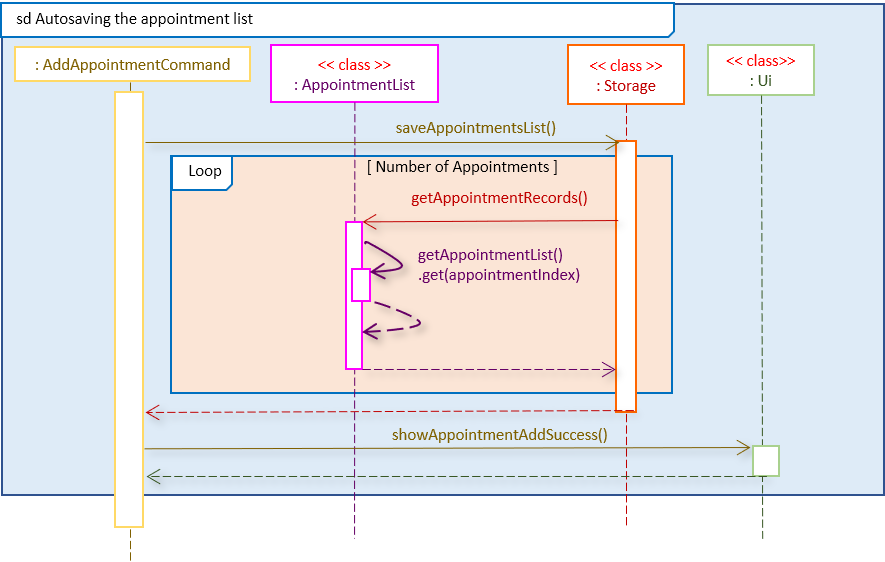
2.2.4.3 ListPatientCommand Class
To display the list of patients, the ListPatientCommand class is called. This class serves as a façade class of
Main and Ui to interact with each other.
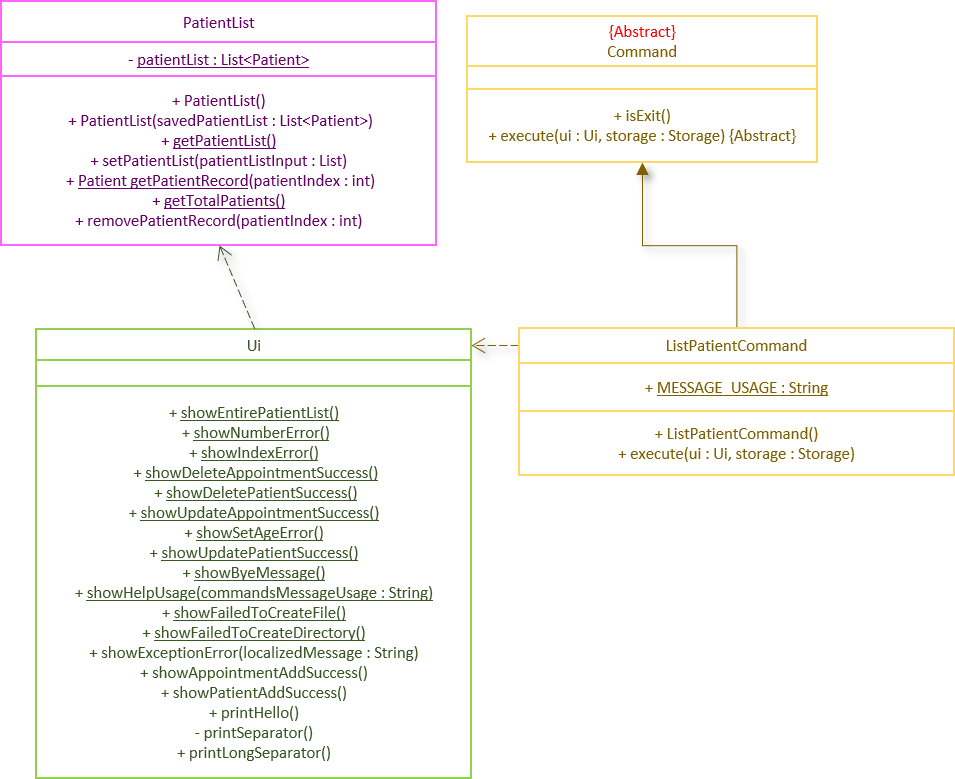
-
This class’ object is first created by the
Parserclass, where it is then returned to theMainclass to have itsexecute(Ui ui, Storage storage)function be called. -
When the
Mainclass calls theexecute(Ui ui, Storage storage)function,ListPatientCommandwill call upon theUi’sshowEntirePatientList()function to display the list of patients.
Below shows the sequence diagram for ListPatientCommand class
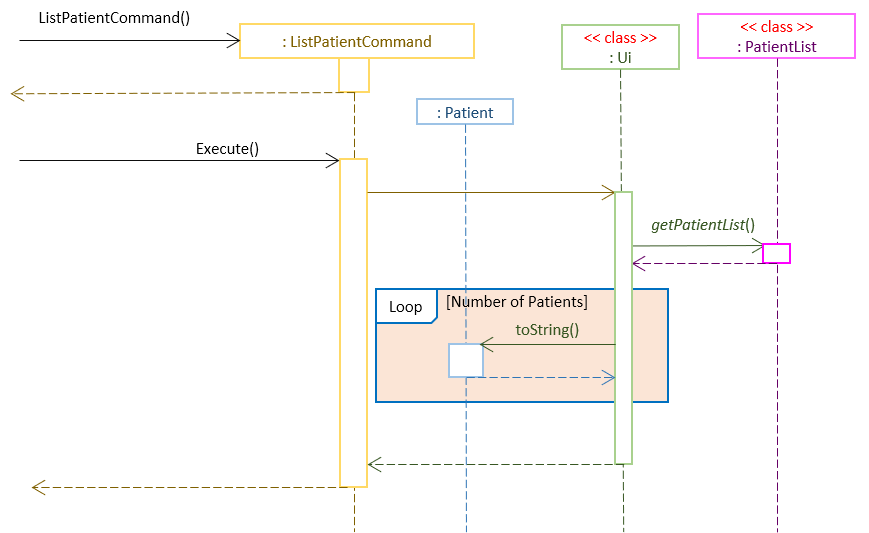
2.2.4.4 ListAppointmentCommand Class
To display the list of appointments, the ListAppointmentCommand class is called. This class serves as a façade
class of Main and Ui to interact with each other.
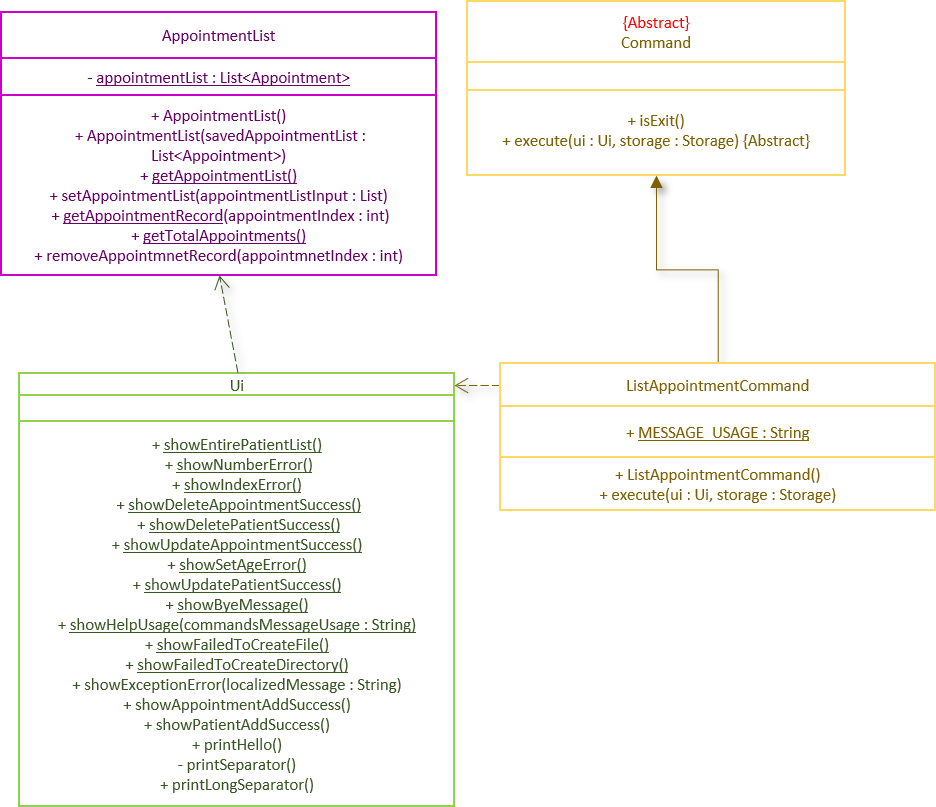
-
This class’ object is first created by the
Parserclass, where it is then returned to theMainclass to have itsexecute(Ui ui, Storage storage)function be called. -
When the
Mainclass calls theexecute(Ui ui, Storage storage)function,ListAppointmentCommandwill call upon theUi’sshowEntireAppointmentList()function to display the list of appointments.
Below shows the sequence diagram for ListAppointmentCommand class
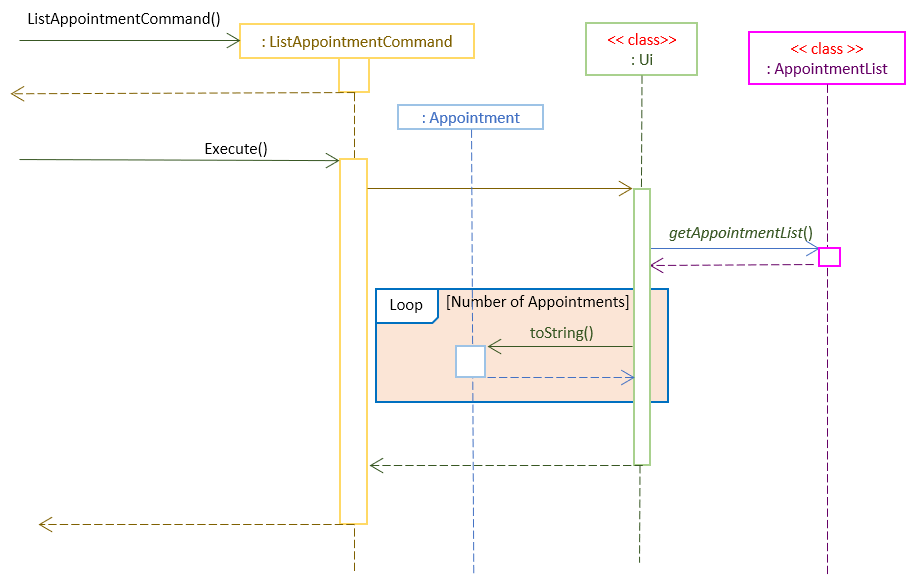
2.2.4.5 PatientIdManger Class
The PatientIdManager class manages the patient ids. It helps to generate unique patient ids for each new
patient. The patient id chosen can either be a new number or a patient id number that is reused from a deleted
patient. By reusing the patient id number from deleted patients, it allows us to have more patient id to use before
the patient id number runs out.
Not only that, it ia also able to check if a patient id exist (as in is there any patients with a specific patient id). This is useful because it prevents the user from adding a new appointment for a non-existing patient.
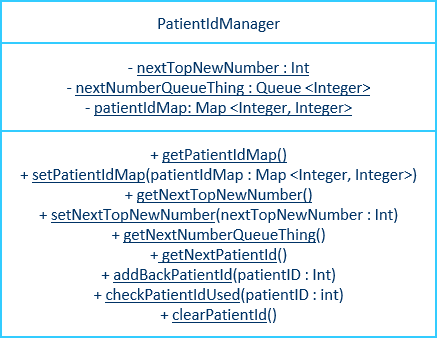
Other than the getter and the setter methods, the most important methods in PatientIdManager are
getNextPatientId(), addBackPatientId(), checkPatientIdUsed() and clearPatientId()
For checkPatientIdUsed(), its purpose is to see if a patient Id is a currently used patient id (as in there is
a patient currently that has this patient id). It achieves this using a hash table called patientIdMap, where the
key is the patient id
number and its value is either null (this patient id has not been used) or 1 (this patient id has been used
). Whenever an appointment is added into HAMS, HAMS needs to ensure that the appointment’s patient id corresponds
to an actual patient in HAMS. This method helps by checking if the patient id supplied in the appointment entry
belongs to an actual patient by checking the key-value pair in the patientIdMap and see if the patient id’s
value is 1 in said map
To summarize checkPatientIdUsed()
-
Get the patient id to check.
-
Let the patient id be the key. See the patient id’s value in the
patientIdMaphash table. If it is 1 , return true (patient currently exist), else return false.
checkPatientIdUsed() is used by the addAppointmentCommand class when adding an appointment to check if
the patient id supplied belongs to a real patient currently in HAMS.
For addBackPatientId(), its purpose is to save the patient id of deleted patients by storing them in the
reusable patient id queue nextNumberQueueThing. This will be useful for the getNextPatientId() method to get a patient id from a deleted patient. We also need to update the patientIdMap to reflect the changes made.
To summarize addBackPatientId()
-
Get the deleted patient id.
-
Check to see if the patient id is a valid id. A valid patient id is an id that does not exist in the reusable patient id queue and its value cannot be below 0 and (equal and above)
nextTopNewNumber. -
If the patient id is a valid id, then add it in the reusable patient id queue. Else, ignore it.
-
Once it is deleted, update the
patientIdMapmap to reflect that the patient id now do not belong to any patient currently (set the corresponding value to null in the map).
addBackPatientId() is used by the deletePatientClass when deleting a patient to store the deleted
patient id number.
For getNextPatientId(), its purpose is to supply a new patient id for a patient, be it a newly created id or an
id from a deleted patient (reusing id). This is achieved with a combination of a queue (called the
nextNumberQueueThing) that serves to store
the
list of
patient ids from deleted patients and an integer that serves to represent the next highest number to use if there
are no patient ids that can be reused.
To elaborate, whenever a patient is deleted, we want to store its patient id somewhere since it can be reused for a
new patient (as it will still retain the uniqueness property of the patient id). Hence, a way to store those deleted
patient’s patient id is to store them in a queue such that we can call upon the queue for any reusable patient ids
. We use a queue because inserting and popping elements in a queue is O(1) time, which makes it fast. If there are
no elements in the queue (as in we have used up all or there isn’t any reusable patient id present), then there
exist another integer (called nextTopNewNumber) that represents a new patient id that has not been used by
any patient before. The value of nextTopNewNumber will be used for the patient id number if the queue is
empty. After which, the nextTopNewNumber value get added by 1.
For example, when we just started HAMS and there has not been any deletion of patient thus far, the reusable
patient id queue is empty. By default, nextTopNewNumber starts from 0. If we were to add 3 patients, then the
first patient will get patient id 0 (which is the value of nextTopNewNumber) currently (we use the value of
nextTopNewNumber if there isn’t any elements present in the resusable patient id queue), while the second
patient gets the value of current nextTopNewNumber (which is 0) + 1, making patient number 2 has patient id
1 and so on and so forth. The third patient will get patient id number 2. However, lets say we deleted patient
number 2 and added a new patient (patient number 4, then patient number 2’s patient id (patient id 1) will be
stored in the queue. For the new patient added (patient number 4), instead of using the current
nextTopNewNumber (which is 2), we will use
the patient number present in the queue, which is 1. Thus, patient number 4 has the patient id of 1.
Finaly, once we chosen a number, we need to update patientIdMap map to reflect that there is now a new patient id that is used by a patient
One property of nextTopNewNumber is that all patient id numbers in the queue should be lesser than
nextTopNewNumber (nextTopNewNumber serves as the current upper-bound of the possible patient id). There
will never exist a reusable patient id number (or any patient id number for that matter) that is bigger than
nextTopNewNumber.
To summarize getNextPatientId()
-
Check if the reusable patient id queue is empty
-
If it is not empty, we take a patient id from the queue.
-
On the other hand, if it is empty, we use the value of
nextTopNewNumberfor the patient id. We then increase the value ofnextTopNewNumberby 1. -
Once we decided on which patient id to use, update the
patientIdMapmap to reflect that the patient id now belongs to a patient (set the corresponding value in the map to 1).
getNextPatientId() is used by the addPatientCommandClass when adding a patient to get a unique patient id
for the new patient.
Lastly, for clearPatientId(), it resets the value of nextTopNewNumber, clears the reusable patient id queue
nextNumberQueueThing and finally clears the hash table patientIdMap. This method serves to reset the
patientIdManager back to its default state.
clearPatientId() is used by both ClearPatientCommand and ClearAllCommand class to reset the
patientIdManager state since both commands clears all the current patients in HAMS, which meant that all the
patient id in HAMS must be reset as there are no patients left.
2.2.4.6 Design considerations for 2.2.4.1 to 2.2.4.5
For the 5 classes listed, there were some other design considerations that was discussed for these 5 classes. Here , we will discuss the other choices and the pros and cons for them.
2.2.4.6.1 Aspect: Facade classes
-
Alternative 1 (current choice): Making all 4 classes facade classes
- Pros:
- Stronger Single Responsibility Principle (SRP) and Separation of Concerns Principle (SoC)
- Cons:
- Higher dependencies and couplings on the other classes to work.
- Pros:
-
Alternative 2: Put the actual adding logic into the classes
- Pros:
- Weaker dependency and couplings on the other classes
- Cons:
- Lower SRP and (SoC)
- Pros:
2.2.4.6.2 Aspect: Autosaving or no
- Alternative 1 (current choice): Allow for autosaving after each command execution
- Pros:
- Allow for recovery when crashing
- Negligible performance effect on higher end computer system
- Cons:
- Since saving is writing to disk, it may be an expensive process for weaker computer system. Weaker computer system may be slowed down by the constant saving
- Pros:
- Alternative 2: Save only when exiting HAMS
- Pros:
- Faster, especially for weaker computer systems
- Cons:
- No recovery (or rather, no recovery for recent information) when HAMS crashes
- Pros:
2.2.4.6.3 Aspect: Generation of Patient Id
- Alternative 1 (current choice): Allow the reuse of the patient Id from deleted patients
- Pros:
- Allow for reuse, which prevents the patient Id number from running out.
- Cons:
- Slightly more complicated implementation. Also it means that there is more information that is required to be saved (such as the list of patient Id to be reused) when HAMS shuts down.
- Pros:
- Alternative 2: Always pick a new number (don’t reuse deleted patient Id number)
- Pros:
- Easier to implement and keep track of. Also, it does not need to save much more information about the patient Id numbers (just need to save the last number assigned).
- Cons:
- Much more likely to run out of patient id numbers, especially if patients are getting added and deleted from HAMS continuously and consecutively.
- Pros:
2.2.4.6.4 Aspect: Deciding how to reuse Patient Id
- Alternative 1 (current choice): For reusable patient id, just choose the patient id number that have not been
assigned the longest
- Pros:
- Easy to implement (just use a Queue) and ensures an O(1) time.
- Cons:
- Patient id number is not really in sequence (it is possible for a bigger patient id number might be assigned first before a smaller patient id number). As a result, the new patient id number is not that predictable (unless you are keeping track of which patient id numbers are deleted first).
- Pros:
- Alternative 2: Sort the reusable patient id first such that the smallest patient id is always reused first
- Pros:
- Patient id number is in sequence (always assign the smaller patient id number first), which seems to make it easier to predict the next patient’s patient id number.
- Cons:
- Sorting is O(n log n) time, hence making it slightly slower than current implementation.
- Pros:
Back to top ↑
2.2.4.7 EditAppointmentCommand Class
To edit an appointment, the EditAppointmentCommand class is used. For this EditAppointmentCommand class, it
serves as a facade class for the Main, Appointment, AppointmentList, Ui and the Storage class to
interact with one another.
Note that if the appointment information given is incorrect due to formatting or value error, EditAppointmentCommand will return an exception and EditAppointmentCommand will not update the appointment record.
-
The
EditAppointmentCommandclass is processed byParser -
When the
Maincallsexecute(Ui ui, Storage storage), theEditAppointmentCommandclass would call upon theAppointmentclass to make anAppointmentObject. It will also check the information given for the appointment and see if the information is valid. -
After which, the
EditAppoinmentCommandobject will call upon theAppointmentListobject to get the record of the record of the appointment based on the index withgetAppointmentRecord. -
After that,
EditAppoinmentCommandwill call thesetAppointmentInfomethod from ```Patient`` to update the appointment. -
The
AppointmentListwill be updated with the newly updated appointment. -
Finally, it will call upon the
Storageclass’ssaveAppoinmentList()function to save the updated appointment list. -
Upon successfully editing the
Appointmentobject into the appointment list, it will call upon theUiclass’showUpdateAppointmentSuccess()function to display the success of adding theappointmentin the appointment list.
Below shows the sequence diagram for EditAppointmentCommand class.
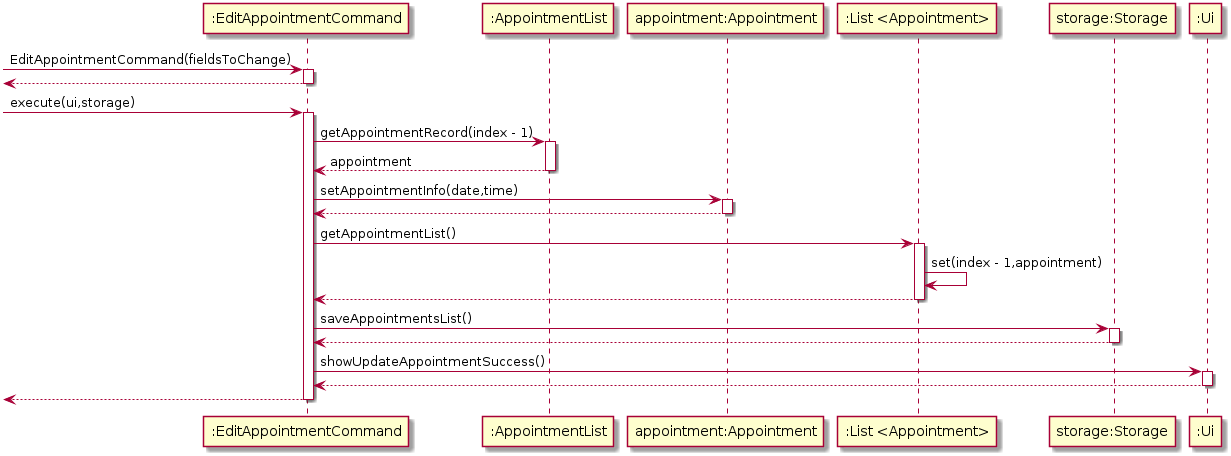
2.2.4.8 EditPatientCommand Class
To edit an appointment, the EditPatientCommand class is used. For this EditPatientCommand class, it
serves as a facade class for the Main, Patient, PatientList, Ui and the Storage class to
interact with one another.
Note that if the patient information given is incorrect due to formatting or value error, EditPatientCommand will return an exception and EditPatientCommand will not update the patient record.
-
The
EditPatientCommandclass is processed byParser -
When the
Maincallsexecute(Ui ui, Storage storage), theEditPatientCommandclass would call upon thePatientclass to make aPatientObject. It will also check the information given for the patient and see if the information is valid. -
After which, the
EditPatientCommandobject will call upon thePatientListobject to get the record of the record of the patient based on the index withgetPatientRecord. -
After that,
EditPatientCommandwill call thesetPatientInfomethod from ```Patient`` to update the patient. -
The
AppointmentListwill be updated with the newly updated patient. -
Finally, it will call upon the
Storageclass’ssavePatienttList()function to save the updated patient list. -
Upon successfully editing the
Patientobject into the appointment list, it will call upon theUiclass’showUpdatePatientSuccess()function to display the success of adding thepatientin the appointment list.
Below shows the sequence diagram for EditPatientCommand class.
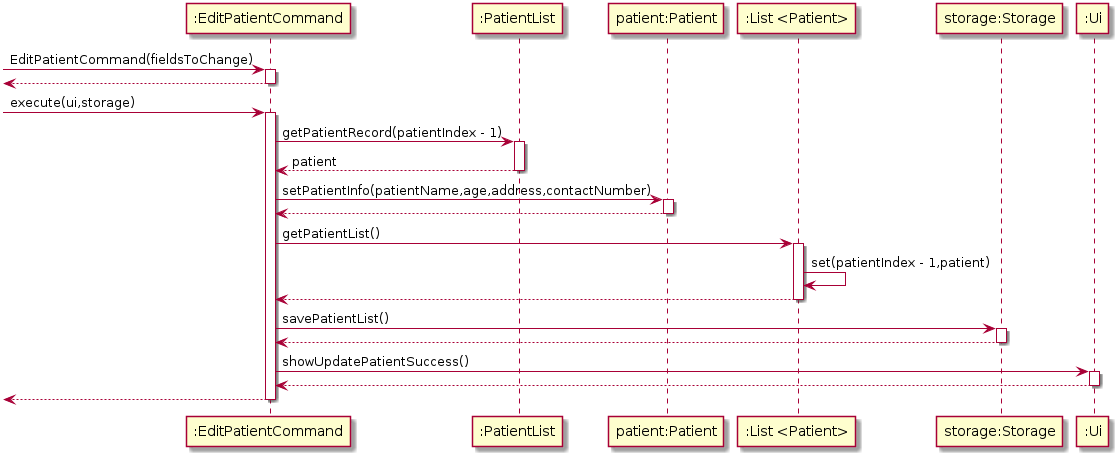
2.2.4.9 DeleteAppointmentCommand Class
To delete an appointment, the DeleteAppointmentCommand class is used. For this DeleteAppointmentCommand class, it
serves as a facade class for the Main, Appointment, AppointmentList, Ui and the Storage class to
interact with one another.
-
The
DeleteAppointmentCommandclass is processed byParser -
When the
Maincallsexecute(Ui ui, Storage storage), theDeleteAppointmentCommandclass would call upon theAppointmentclass to make anAppointmentObject. -
After which, the
DeleteAppoinmentCommandobject will call upon theAppointmentListobject to get the appointment list withgetAppointmentList()and remove the appointment record with given index fromgetAppointmentRecord() -
Finally, it will call upon the
Storageclass’ssaveAppoinmentList()function to save the updated appointment list. -
Upon successfully deleting the
Appointmentobject into the appointment list, it will call upon theUiclass’showDeleteAppointmentSuccess()function to display the success of deleting theappointmentfrom the appointment list.
Below shows the sequence diagram for DeleteAppointmentCommand class.
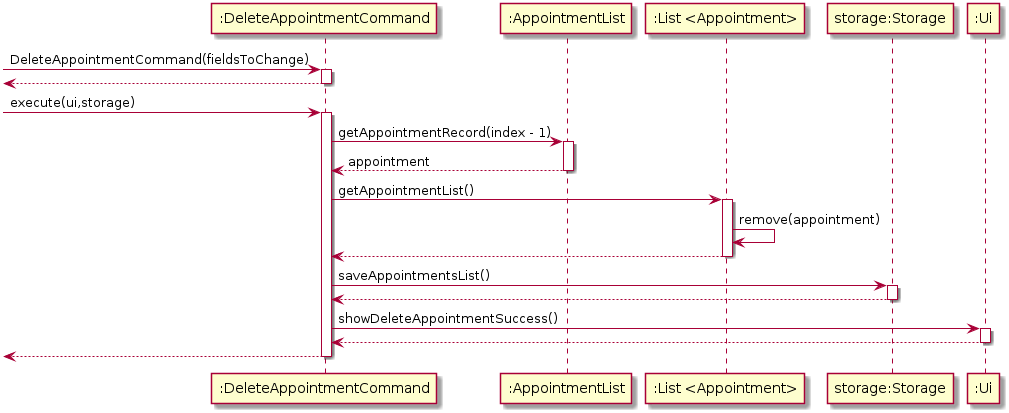
2.2.4.10 DeletePatientCommand Class
To delete an appointment, the DeletePatientCommand class is used. For this DeletePatientCommand class, it
serves as a facade class for the Main, Appointment, AppointmentList, Ui and the Storage class to
interact with one another.
-
The
DeletePatientCommandclass is processed byParser -
When the
Maincallsexecute(Ui ui, Storage storage), theDeletePatientCommandclass would call upon thePatientclass to make aPatientObject. -
After which, the
DeletePatientCommandobject will call upon thePatientListobject to get the patient list withgetPatientList()and remove the patient record with given index fromgetPatientRecord() -
Then it will go through all the items in
AppointmentListwith the patientId of the patient that has been deleted -
Finally, it will call upon the
Storageclass’ssavePatientList()function to save the updated patient list. -
Upon successfully deleting the
Patientobject from the patient list, it will call upon theUiclass’showDeletePatientSuccess()function to display the success of deleting thepatientfrom the patient list.
Below shows the sequence diagram for DeletePatientCommand class.
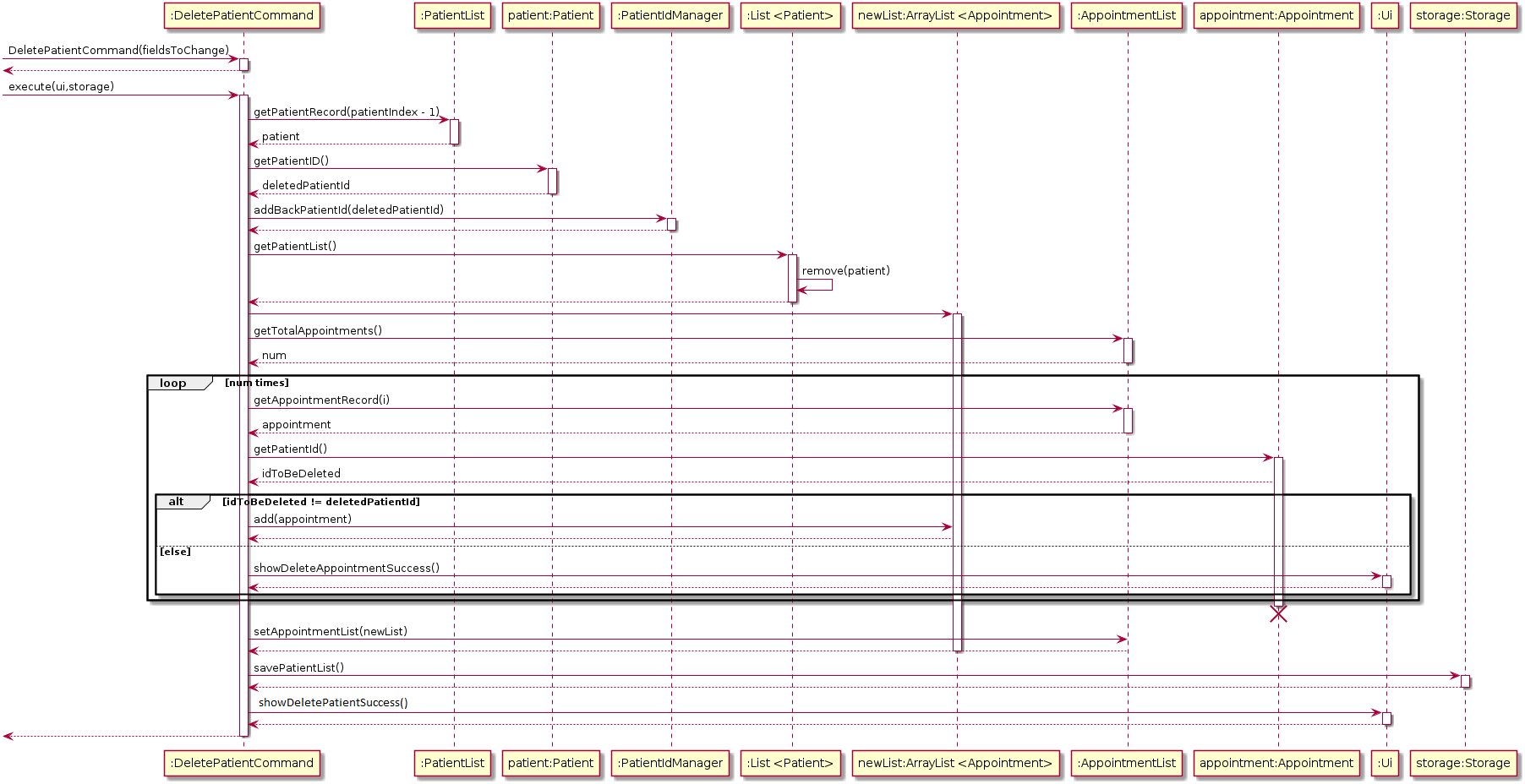
2.2.4.11 ClearAllCommand Class
To clear both appointment list and patient list, the ClearAllCommand class is used. For this ClearAllCommand class, it
serves as a facade class for the Main, PatientList, AppointmentList, Ui and the Storage class to
interact with one another.
-
The
ClearAllCommandclass is processed byParser -
When the
Maincallsexecute(Ui ui, Storage storage), theClearAllCommandclass would call upon thePatientListandAppointmentListto clear all the items in both lists -
It will call upon the
Storageclass’ssavePatientList()andsaveAppointmentList()function to save the updated patient list and appointment list. -
Upon successfully clearing all the lists, it will call upon the
Uiclass’showAllItemsDeleted()function to display the success of clearing all the items.
Below shows the sequence diagram for ClearAllCommand class.
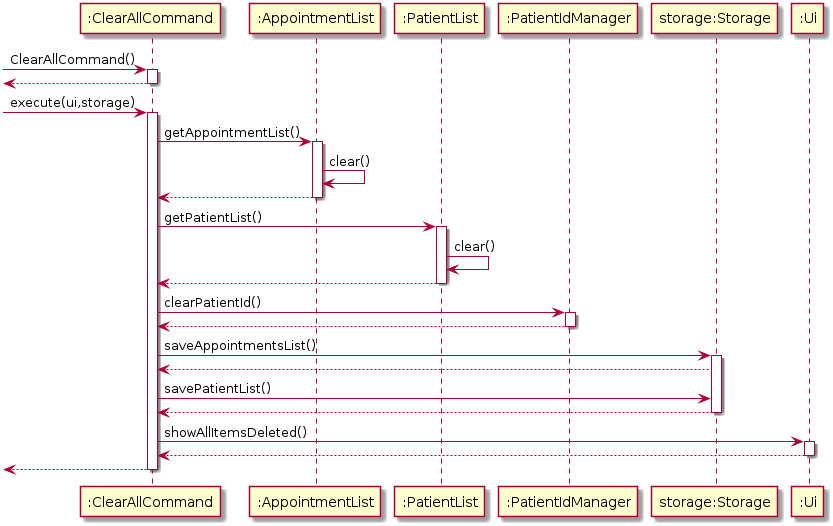
2.2.4.12 ClearAppointmentCommand Class
To clear appointment list, the ClearAppointmentCommand class is used. For this ClearAppointmentCommand class, it
serves as a facade class for the Main, AppointmentList, Ui and the Storage class to
interact with one another.
-
The
ClearAppointmentCommandclass is processed byParser -
When the
Maincallsexecute(Ui ui, Storage storage), theClearAppointmentCommandclass would call upon theAppointmentListto clear the items in appointment list. -
It will call upon the
Storageclass’ssaveAppointmentList()function to save the updated appointment list. -
Upon successfully clearing the list, it will call upon the
Uiclass’showAppointmentsDeleted()function to display the success of clearing all the items in appointment list.
Below shows the sequence diagram for ClearAppointmentCommand class.
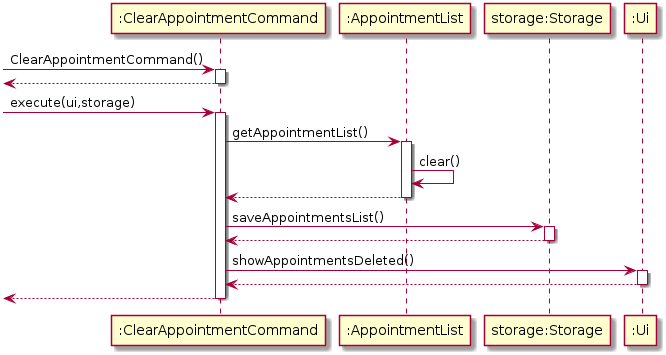
2.2.4.13 ClearPatientCommand Class
To clear patient list, the ClearPatientCommand class is used. For this ClearPatientCommand class, it
serves as a facade class for the Main, PatientList, Ui and the Storage class to
interact with one another.
-
The
ClearPatientCommandclass is processed byParser -
When the
Maincallsexecute(Ui ui, Storage storage), theClearPatientCommandclass would call upon thePatientListto clear the items in patient list. -
It will call upon the
Storageclass’ssavePatientList()function to save the updated patient list. -
Upon successfully clearing the list, it will call upon the
Uiclass’showPatientsDeleted()function to display the success of clearing all the items in patient list.
Below shows the sequence diagram for ClearPatientCommand class.
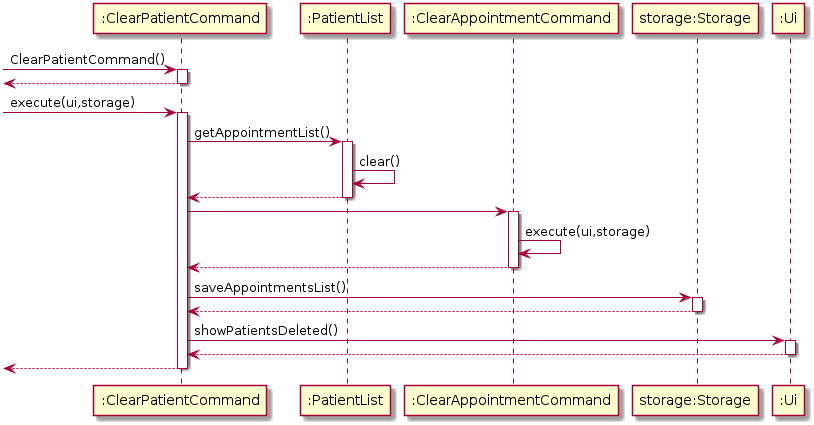
2.2.4.14 FindAppointmentCommand Class
To search the AppointmentList by keyword, the FindAppointmentCommand class is used. For this class, it serves as a
facade class for the Main, AppointmentList, Ui and the Storage class to interact with one another.
-
The
FindAppointmentCommandclass is processed by Parser -
When the Main calls
execute(Ui ui, Storage storage), it createssearchResults, a new List to holdAppointmentobjects. -
The
FindAppointmentCommandclass gets the existing list of Appointment objects from AppointmentList using the methodgetAppointmentList(). -
After which, the
FindAppointmentCommandobject will iterate through Appointment objects within the list. According to the format of the input, this class searches specific fields: * if input was dd/mm/yyyy, it searches date fields of each Appointment only. * if input was hh:mm (am/pm), it searches time fields of each Appointment only. -
If an Appointment object does contain the search keyword, it will be added to searchResults.
-
searchResults then invokes the ui method
printAppointmentSearchResults()to print the matching Appointment results to the console. (if searchResults is non-empty). Otherwise, the method outputs a message saying no search results were found.
Below shows the sequence diagram for FindAppointmentCommand class.
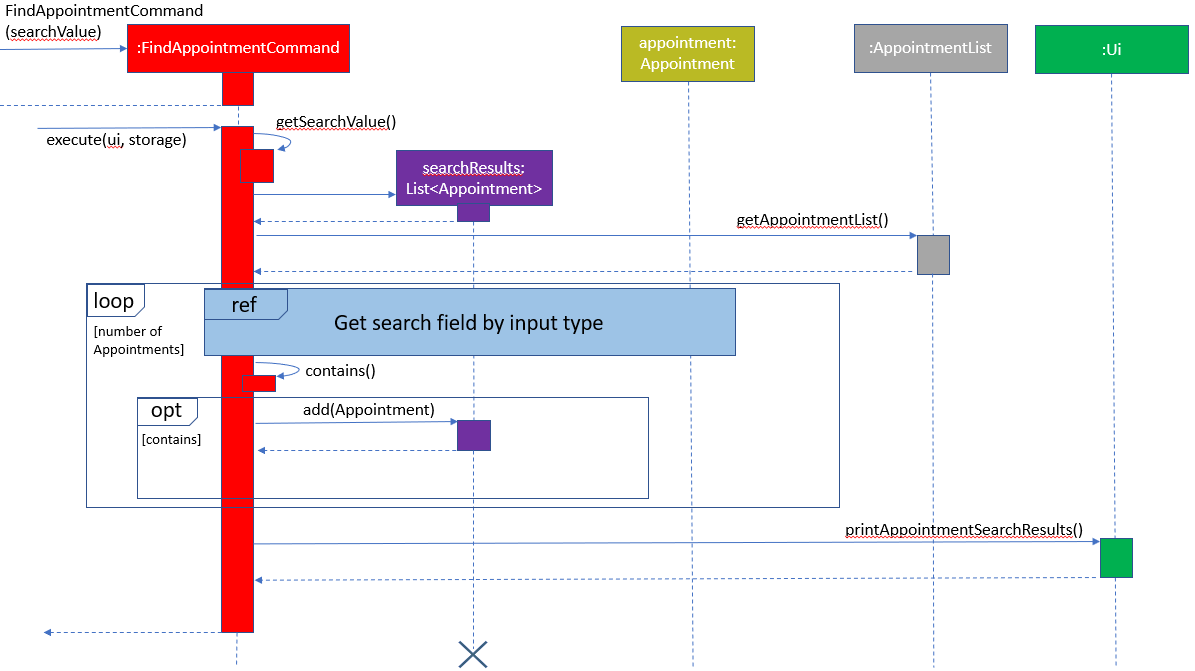
2.2.4.14.1 Design Considerations
Aspect: Format of Search Input
- Alternative 1 (current choice): Search only by Time or Date input
- Pros:
- Easier implementation
- Greater compatibility with TimeConverter class, able to validate input more easily
- Cons:
- Unable to filter existing Appointments more efficiently to find a specific Appointment
- Pros:
- Alternative 2: Support multiple fields with specific delimiters (eg.
finda \date 01/04/2020 \time 01:00 PM)- Pros:
- Allows us to be more specific when filtering and searching for a certain Appointment.
- Cons:
- Not as compatible with TimeConverter class. Requires more sophisticated methods to parse input, as well as error handling to handle complicated error cases for multiple input fields.
- Pros:
2.2.4.15 FindPatientCommand Class
To search the PatientList by keyword, the FindPatientCommand class is used. For this class, it serves as a
facade class for the Main, PatientList, Ui and the Storage class to interact with one another.
-
The
FindPatientCommandclass is processed by Parser -
When the Main calls
execute(Ui ui, Storage storage), it createssearchResults, a new List to holdPatientobjects. -
The
FindPatientCommandclass gets the existing list of Patient objects from PatientList using the methodgetPatientList(). -
After which, the
FindPatientCommandobject will iterate through Patient objects within the list. This class searches through every field in the Patient object for the search keyword. -
If a Patient object does contain the search keyword, it will be added to searchResults.
-
searchResults then invokes the ui method
printPatientSearchResults()to print the matching Patient results to the console. (if searchResults is non-empty). Otherwise, the method outputs a message saying no search results were found.
Below shows the sequence diagram for FindPatientCommand class.
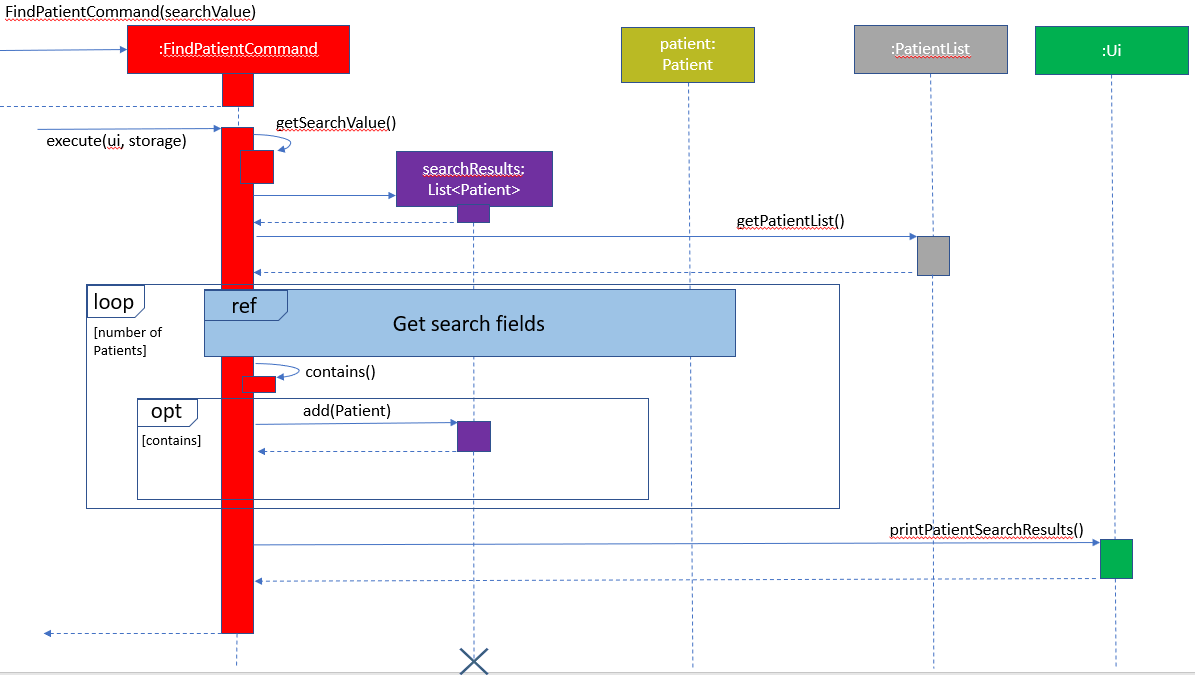
2.2.4.15.1 Design Considerations
Aspect: Format of Search Input
- Alternative 1 (current choice): General search (search value across all fields)
- Pros:
- Easier implementation
- Cons:
- May be relatively slower in obtaining search results due to complexity of this method
- Pros:
- Alternative 2: Support multiple fields with specific delimiters (eg.
findp \name Bob \address Bukit Batok Ave 2)- Pros:
- Allows us to be more specific when filtering and searching for a certain Patient
- Cons:
- Requires us to manage the different possible combinations of fields in the input (there are 4 fields, resulting in 24 possible combinations). We would need additional clauses and exceptions to handle the increased complexity of this input.
- Pros:
2.2.4.16 HelpCommand Class
To see the help usage for the commands in HAMS, the HelpCommand class is used. For this HelpCommand class, it
serves as a facade class for the Main, Ui class to interact. The purpose of the class is to print out the usage
for all the commands in HAMS through showHelpUsage() in Ui.
Below shows the sequence diagram for HelpCommand class.
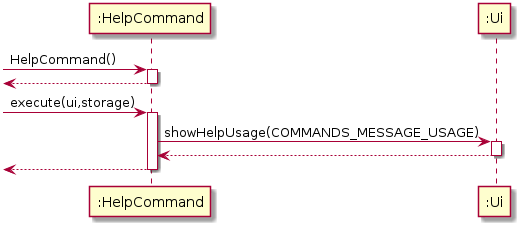
2.2.4.17 ExitCommand Class
To print the bye message for HAMS, the HelpCommand class is used. For this ClearPatientCommand class, it
serves as a facade class for the Main, Ui class to interact.
-
The
Mainclass will check whetherisExit()is set to be true or not. -
Uiclass’showByeMessage()method is used to print the bye message for users.
Below shows the sequence diagram for ExitCommand class.
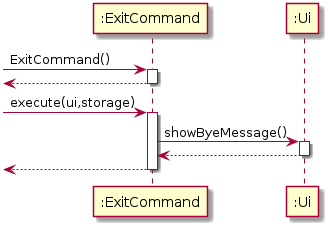
Back to top ↑
2.2.5 Parser module
This section describes the implementation of Parser class, as well as the design considerations and rational behind the current implementation.
The main purpose of the Parser class is as below.
- To interpret user inputs so that the correct command can be executed
- Functions as the first line to sanitize user input
As such, the Parser class only has one publicly callable method and that returns the command object for execution. To assist the public method, Parser class has multiple private helper methods, as well as access to the Exception handler to ensure that the user input is formatted correctly. This way, purpose 1 and 2 is satisfied.
2.2.5.1 Object creation and steps in input interpretation
- The
Parserobject is first created inDukeclass and subsequently used until program termination. - User input is received and handed over to
Parserobject for interpretation. - In the
Parserobject, the type of command is first determined via helper methodgetCommand(userInput).- Example:
addp \age 23 \name Justin, theaddpcommand will be determined.
- Example:
- The remaining fields will be recorded in a hashMap through either
fillPatientFields(userInput)orfillAppointmentFields(userInput)depending on the command type in Step 3.- The type of category of the command can be determined based on the last alphabet of the first word.
- The command
addphas the last alphabet isp,fillPatientFields()will be called. Likewise, if it iseadda, it will befillAppointmentFields(). - Example:
addp \name Sam \age 18, the methodfillPatientFields(userInput)will be called. The hashMap will contain age -> 23, name -> Sam.
- At the end of the execution, a reference to the command object will be returned.
Sequence Diagram when parseCommand(userInput) is initially called
The userInput is first captured and then passed into parseCommand(userInput) method. As seen in the Sequence Diagram
above, different appointment will result in different alternate paths taken.
Below is the list of commands available as of v2.1. You can find their individual Sequence Diagram in the following sections below.
- Adding a patient:
addp - Editing a patient:
editp - Deleting a patient:
deletep - Adding an appointment:
adda - Editing an appointment:
edita - Deleting an appointment:
deletea - Finding a patient:
findp - Finding an appointment:
finda - Clearing patient list:
clearp - Clearing appointment list:
cleara - Clearing all list:
clearall - Show help menu:
help - Exit program:
exit
We decided to categorize clearp, cleara, clearall, help and exit, in the [else] alt branch. This is because
these 4 commands do not require any additional parsing. As such, the default [else] will be executed for these commands.
You can find the Sequence diagram for default [else] here.
Sequence Diagram for addp
When you provide an addp command, an internal method, getPatientFieldAdd(userInput) is called. A HashMap will
then be created.
We can update the HashMap by calling this method - fillPatientFields(userInput, HashMap). The HashMap
based on the fields the user provide.
For example a valid user input: addp \name Justin \age 23. fillPatientFields(userInput, HashMap) will update the HashMap
to contain these key value pairs.
- name -> Justin
- age -> 23
Next, we will call DukeException#checkEmptyField() to ensure that there is at least 1 field provided that is not empty.
Finally, a hashMap will be returned so that the AddPatientCommand object can be created.
Sequence Diagram for editp
When you provide an editp command, an internal method, getPatientFieldEdit(userInput) is called. A HashMap will
then be created.
We first get the index value from the userInput and check its value. If it is not valid, we will throw an error.
Supposed the index is valid, then we move on to filling the hashMap. The steps of filling the hashMap is similar to that of
addp.
Sequence Diagram for deletep
When you provide an deletep command, an internal method, getPatientFieldDelete(userInput) is called. A HashMap will
then be created.
We first get the index value from the userInput and check its value. If it is not valid, we will throw an error.
When the index is valid, we will add the index and its value into the HashMap.
This HashMap will then be returned so that a DeletePatientCommand object can be created.
Sequence Diagram for adda
When you provide an adda command, an internal method, getAppointmentFieldAdd(userInput) is called. A HashMap will
then be created.
We can update the HashMap by calling this method - fillAppointmentFields(userInput, HashMap). The HashMap
based on the fields the user provide.
For example a valid user input: adda \time 1234 \date 22/05/2020 \pid 1. fillAppointmentFields(userInput, HashMap) will update the HashMap
to contain these key value pairs.
- time -> 1234
- date -> 22/05/2020
- pid -> 1
Next, we will call DukeException#checkEmptyField() to ensure that there is at least 1 field provided that is not empty. Then, we will call DukeException#checkPidEmpty() to ensure that the pid field is not empty. This is because pid is compulsory.
Finally, a hashMap will be returned so that the AddAppointmentCommand object can be created.
Sequence Diagram for edita
When you provide an edita command, an internal method, getAppointmentFieldEdit(userInput) is called. A HashMap will
then be created.
We first get the index value from the userInput and check its value. If it is not valid, we will throw an error.
Supposed the index is valid, then we move on to filling the hashMap.
Next, we will call DukeException#checkEmptyField() to ensure that there is at least 1 field provided that is not empty.
Finally a hashMap will be returned so that the EditAppointmentCommand object can be created.
Sequence Diagram for deletea
When you provide a deletea command, an internal method, getAppointmentFieldDelete(userInput) is called. A HashMap will
then be created.
We first get the index value from the userInput and check its value. If it is not valid, we will throw an error.
When the index is valid, we will add the index and its value into the HashMap.
This HashMap will then be returned so that a DeleteAppointmentCommand object can be created.
Sequence Diagram for findp
When you provide a findp command, an internal method, getSearchValue(userInput) is called. The sequence diagram for
for this method is here. It will return the value to be searched.
When this search value, a FindPatientCommand will be created and a reference to it will be returned.
Sequence Diagram for finda
When you provide a finda command, an internal method, getSearchValue(userInput) is called. The sequence diagram for
for this method is here. It will return the value to be searched.
When this search value, a FindAppointmentCommand will be created and a reference to it will be returned.
Sequence Diagram for default [else]
As explained above, the commands clearp, cleara, clearall, help and exit
will be directed to this branch.
This is because they do not require any additional parsing.
In addition, unknown commands will be directed here as well.
Sequence Diagram for the creation of the command Object
Based on the different type of commands, different command object will be return.
For example, a adda command will return a addAppointmentCommandObject.
All unknown commands will be directed to the [else] branch, which will throw an DukeExceptions#unknownCommandException.
Sequence Diagram for get search value
The above Sequence Diagram depicts how the method searchValue(String[]) works. It takes in an array of String and finds
We first trim the userInput to get rid of any excess trailing whitespaces.
Then, the userInput is spilt on the first whitespace and store in a String array.
We can pass this String array into this method and find the value of the search value at index 1 of the String Array.
If the length of the String array is 1, this means that the user did not supply any search value. Thus the DukeExceptions#noFieldCommandException will be thrown.
If not, the search value will be located at index 1 and we will return this as the search value.
Sequence Diagram for calling an enum
| Enum | PatientFieldKeys | AppointmentFieldKeys |
|---|---|---|
| . | INDEX | INDEX |
| . | NAME | DATE |
| . | AGE | TIME |
| . | ADDRESS | . |
| . | CONTACT_NUMBER | . |
Sequence Diagram for error checking when DukeExpcetion#checkFieldEmpty is called
If all fields are empty, this exception will be thrown
Sequence Diagram for error checking when DukeExpcetion#checkIndexValidity is called
If the index provided are invalid, this exception will be thrown.
Sequence Diagram for error checking when DukeException#checkPidEmpty is called
If the pid field is not provided, this exception will be thrown.
| checkFieldEmpty | checkIndexValidity | checkPidEmpty |
|---|---|---|
| Based on the above enum table, checks that at least 1 field is provided. Throws NoFieldCommandException if all fields are empty |
Check that the index provided is valid. If it is less than 0 or not an integer, throw InvalidIndex and IndexNotInteger respectively. |
Check that pid is provided. If no pid is provided, throw checkPidEmptyException. |
2.2.5.2 Design considerations
Aspect: Symbol for delimiter
- Alternative 1 (current choice): Backslash
\is used.-
Pros:
- Backslash is the least used symbol in the english language.
-
Cons:
-
More caution must be exercised to used backslash in computer language as REGEX uses it as a delimiter by default.
-
Might break the speed at which user type since backslash is located where it would be hard to reach with regular typing.
-
-
- Alternative 2: Slash is
/used.-
Pros:
- easier to access when typing
-
Cons:
- some people may have a slash in their legal name -
Suresh S/O Ravindran
- some people may have a slash in their legal name -
-
Aspect: Symbol for delimiter
- Alternative 1 (current choice): Each command will call its own method to parse field.
-
Pros:
- Decouples commands from method, making the code more modular.
- Increases testability, bugs found can be isolated to the individual command and method respectively
- Changes to one method will only affect the command calling it and vice-versa.
- Easier to understand code.
-
Cons:
- Code duplication may increase.
-
- Alternative 2: Every command calls a common method to parse the remaining fields.
-
Pros:
- Less code duplication
- Harder to understand code as different commands call the same method.
-
Cons:
-
Leads to tighter coupling
-
All command depends on this common method to parse fields, if the method changes, it may return the wrong result for some commands.
-
-
Back to top ↑
3. User Stories
| Version | As a … | I want to … | So that I can … |
|---|---|---|---|
| v1.0 | new admin assistant | see usage instructions | refer to them when I forget how to use the application |
| v1.0 | admin assistant | add upcoming appointments | set the patient’s future appointments |
| v1.0 | admin assistant | obtain upcoming appointments | remind patients of their appointment |
| v1.0 | admin assistant | reschedule appointments | help the patient change his appointment dates |
| v1.0 | admin assistant | add and delete patient’s address | update the information in the system |
| v1.0 | admin assistant | add and delete telephone number | contact the patient directly |
| v1.0 | admin assistant | have an interface | easily update the patient’s personal information |
| v1.0 | admin assistant | register new patient’s medical information | so that it can be stored and accessed whenever needed |
| v1.0 | admin assistant | save my data on shutdown | continue my work the next day |
| v2.0 | busy admin assistant | immediately know if the patient is scheduled for today | so I can process them better |
| v2.0 | admin assistant | be able to find a specific patient | check their appointment details |
| v2.0 | admin assistant | clear my lists | keep my list organized when the appointment is over |
Back to top ↑
4. Non-Functional Requirements
-
HAMS should be usable with minimal training, all commands should be self-explanatory and viewing the in-application help menu should be sufficient for basic usage.
-
HAMS should be resistant to software crashes and if a crash does happens, the latest patient and appointment list should be saved. In addition, user should be able to manually save their work.
-
Each function of HAMS can be executed in a single line.
-
HAMS should be fast and responsive
Back to top ↑
5. Instructions for Manual Testing
5.1 Startup, shutdown and restart with saved list.
- Initial launch
- Download the latest release from here
- Move the .jar to an empty folder
- Open Command Prompt
- In Command Prompt, change your current working directory to the folder containing the .jar using $
cd <Path of folder containing .jar> - Run the .jar using $
java -jar hams-2.0.jar
Expected: Shows a welcome screen for HAMS.
- Shutdown
- Run the .jar file
- Test case:
exit
Expected: Bye message is printed and program closes.
- Restart with saved list
- Run the .jar file
- Add some patients and appointments.
- Restart the program
- Test case:
listp
Expected: Previous saved list should be shown.
5.2 Adding a patient
- Successfully adding a patient (All fields)
- Run the .jar file.
- Test case:
addp \name Justin \age 23 \address Pasir Ris \phone 91234567
Expected: Success message is printed. To double check, type
listpand ensure that the test case is inside. - Successfully adding a patient (at least 1 field)
- Run the .jar file.
- Test case:
addp \name Sam
Expected: Success message is printed. HAMS accept
addpas long as 1 field is present. To double check, typelistpand ensure that the test case is inside. - Unsuccessful add a patient (no fields provided)
- Run the .jar file.
- Test case:
addp
Expected: Error message is printed. To double check, type
listpand ensure that the test case is not inside.
5.3 Editing a patient
- Successfully editing a patient
- Prerequisites: list all patients using
listp. Multiple patients already in list. - Test case:
editp \index 1 \name Emma
Expected: Success message is printed. To double check, type
listpand compare the changes from the old list. - Prerequisites: list all patients using
- Unsuccessfully editing a patient
- Prerequisites: list all patients using
listp. Less than 100 patients already in list. - Test case 1:
editp \index 100 \name Emma - Test case 2:
editp \index 1 \name Emma \age -100 - Test case 3:
editp \index 1 \name Emma \age String
Expected: For all test cases, error message printed. No patients will be edited. To double check, type
listpand compare the changes from the old list and ensure that the test cases are not being edited.- Test case 1 fails because the index is greater than the number of patients in the list
- Test case 2 and 3 fails because the provided age is of wrong format.
Note: For test case 1, please ensure that the given index is more than the current patients in the list
- Prerequisites: list all patients using
5.4 Delete a patient
- Successful deleting a patient
- Prerequisites: list all patients using
listp. Multiple patients already in list. - Test case:
deletep \index 1
Expected: First patient in the list is deleted.
- Prerequisites: list all patients using
- Unsuccessful deleting a non-existing patient
- Prerequisites: list all patients using
listp. 10 patients in list. - Test case:
deletep \index 11
Expected: Error message is printed. No patients will be delete. To double check, type
listpand compare from the previous list that no patients is deleted from the list.Note: For this test case, please ensure that the given index is more than the current patients in the list
- Prerequisites: list all patients using
5.5 Add an appointment
- Successful Adding an appointment
- Run the .jar file.
- Test case:
adda \pid 1 \time 1234 \date 22/05/2020
Expected: Success message is printed. To double check, type
listaand ensure that the test case is inside. - Unsuccessful adding an appointment
- Run the .jar file.
- Test case 1:
adda \time 1234 \date 22/05/2020 - Test case 2:
adda \time 9999 \date 22/05/2020 \pid 1 - Test case 3:
adda \time 1234 \date 31/02/2020 \pid 1
Expected: Error message is printed for all 3 cases. To double check, type
listaand ensure that the test case is not inside.-
Test case 1 fails because pid is compulsory
-
Test case 2 and 3 fails because of invalid time and date respectively.
5.6 Edit an appointment
- Successfully editing an appointment
- Prerequisites: list all patients using
lista. Multiple appointments already in list. - Test case:
edita \index 1 \time 1234
Expected: Success message is printed. To double check, type
listaand compare the changes from the old list. - Prerequisites: list all patients using
- Unsuccessfully editing an appointment
- Prerequisites: list all appointments using
lista. Less than 100 appointments already in list. - Test case 1:
editp \index 100 \time 1234 - Test case 2:
editp \index 1 \date 31/02/2020 \time 1234 - Test case 3:
editp \index 1 \date 22/05/2020 \time 9999
Expected: For all test cases, error message printed. No appointments will be edited. To double check, type
listaand compare the changes from the old list and ensure that the test cases are not being edited.- Test case 1 fails because the index is greater than the number of appointments in the list
- Test case 2 and 3 fails because the provided time and/or time is invalid.
Note: For test case 1, please ensure that the given index is more than the current appointments in the list
- Prerequisites: list all appointments using
5.7 Delete an appointment
- Successful deleting an appointment
- Prerequisites: list all appointments using
listp. Multiple appointments already in list. - Test case:
deletea \index 1
Expected: Success message is printed. First appointment in the list is deleted. To double check, type
listaand compare the changes from the old list. - Prerequisites: list all appointments using
- Unsuccessful deleting a non-existing appointment
- Prerequisites: list all appointments using
lista. 10 appointments in list. - Test case:
deletea \index 11
Expected: Error message is printed. No appointments will be delete. To double check, type
listaand compare from the previous list that no appointments is deleted from the list.Note: For this test case, please ensure that the given index is more than the current appointments in the list
- Prerequisites: list all appointments using
5.8 Find patients and Find Appointment
- Successful finding patients
- Prerequisites: list all patients using
listp. Multiple patients in the list. The value to be search is also inside the list. - Test case:
findp Justin
Expected: Success message is printed, all matched patient records will be listed.
Note: For this test case, please ensure that the search value already exist in the patient list.
- Prerequisites: list all patients using
- Unsuccessful finding patient
- Prerequisites: list all patients using
listp. Multiple patients in the list. The value to be search is not inside the list. - Test case:
findp abc123123abc123
Expected: Error message stating not records found will be printed.
Note: For this test case, please ensure that the search value does not exist in the patient list.
- Prerequisites: list all patients using
- Successful finding appointments
- Prerequisites: list all appointments using
lista. Multiple appointments in the list. The value to be search is also inside the list. - Test case:
finda 22/05/2020
Expected: Success message is printed, all matched appointment records will be listed.
Note: For this test case, please ensure that the search value already exist in the patient list.
- Prerequisites: list all appointments using
- Unsuccessful finding appointments
- Prerequisites: list all appointments using
lista. Multiple appointments in the list. The value to be search is not inside the list. - Test case 1:
finda 22/05/2025 - Test case 2:
finda 2020/05/22
Expected: Error message printed, no records should be shown.
- Test case 1 fails because the date cannot be found in the appointment list.
- Test case 2 fails because the provided date format is wrong.
- Prerequisites: list all appointments using
5.9 Clear patient, clear appointment, clear all commands
- Successful clearing patient list
- Prerequisites: list all patients using
listp. Multiple patients in the list. - Test case:
clearp
Expected: Success message is printed, patient list cleared. To double check, type
listpand ensure the list is empty. - Prerequisites: list all patients using
- Unsuccessful clearing patient list
- Prerequisites: list all patients using
listp. It must be a empty - Test case:
clearp
Expected: Error message stating there is nothing to clear.
- Prerequisites: list all patients using
- Successful clearing appointment list
- Prerequisites: list all appointments using
lista. Multiple appointments in the list. - Test case:
cleara
Expected: Success message is printed, appointments list cleared. To double check, type
listaand ensure the list is empty. - Prerequisites: list all appointments using
- Unsuccessful clearing appointment list
- Prerequisites: list all appointments using
lista. It must be a empty - Test case:
cleara
Expected: Error message stating there is nothing to clear.
- Prerequisites: list all appointments using
- Successful clear all list
- Prerequisites: list all patients and appointments using
listpandlista. Multiple records in both list. - Test case:
clearall
Expected: Success message printed. Both list cleared. To double check, type
listpandlistato to ensure that both lists are empty. - Prerequisites: list all patients and appointments using
- Unsuccessful clearing of all list
- Prerequisites: list all patients and appointments using
listpandlista. Both list must be empty - Test case:
clearall
Expected: Error message printed stating that there is nothing to clear.
- Prerequisites: list all patients and appointments using
